The ALMONDBURIAN
THE MAGAZINE OF THE OLD ALMONDBURIANS’ SOCIETY

(Opposite): This

THE MAGAZINE OF THE OLD ALMONDBURIANS’ SOCIETY

(Opposite): This
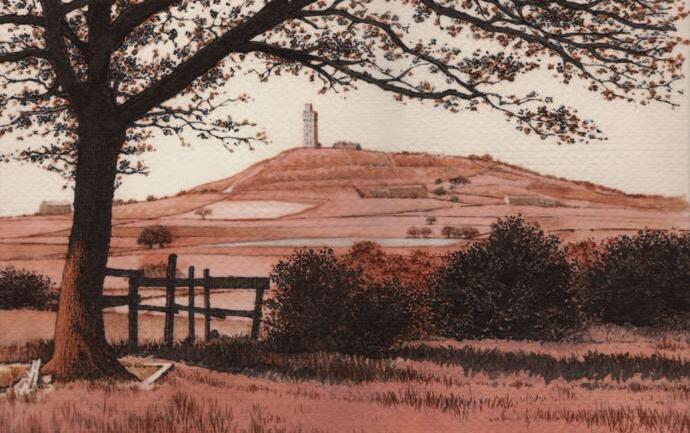
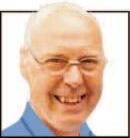
The magazine of The Old Almondburians’ Society
W)ELCOME to the November issue of The Almondburian. I hope you enjoy it.
Last issue we mentioned the project to build a seating area in the yard where the Big Tree used to stand. I am delighted to say that we have already received a number of substantial donations: see page 33.The plan is for the seating to be built as soon as the temporary classrooms in that area have been removed early in the new year. Many thanks to all those who have contributed and a reminder there is still time for any who may
have wanted to contribute but simply forgot. We had another successful Heritage Open Days event on 18th September when the School was once again open for the public to look round (report: page 20). Unfortunately, the West Yorkshire Archive Service were unable to let us have our Royal Charter for display this year, but we are hopeful it will be on display at the Annual Dinner in November.
We ask all those wishing to attend the Dinner to get their applications for tickets in as soon as possible as numbers are restricted for
a number of reasons. At the time of going to press the number of those expecting to attend is already approaching 60, which Andrew, our Secretary, says is very unusual. No doubt it’s partly because of David Morphet and Bob Field, our two distinguished speakers, and the planned presence of Dave Bush to sign copies of his new book. But also I suspect that people have missed getting out and socialising during the pandemic. But the good news is that the prospect of a ‘full house’ looks very likely, so don’t leave it too late to apply: see page 13.
At the Dinner we are hoping to take photographs and shoot a video to mark what is still officially our Centenary Dinner. As such we hope as many Vice Chairmen and former Chairmen of the Society will be able to attend.
Those coming along to the Dinner will have the opportunity to look round not only the old part of School, but also the new buildings presently being erected. Ian Rimmer, our Principal, is confident that the new teaching block (see page 6) will be ready for use by students early in the New Year.
The Westgate project is now complete and a recent financial review has valued the housing stock owned by the School Trust in excess of £2.25 million which vindicates the large investment put into the Westgate development. It will be good to see a large monthly return from this investment going into the accounts of the Trust for the future use by School.
At a recent meeting of the School Foun-
dation, the Chairman, Colin Bamford announced his intention to retire now theWestgate project has been completed. Colin will be a sad loss from the team of Trustees. He has led by hard work and a willingness to do anything in his power to improve the Trust and the role it can play in helping the School and its students. His manner and leadership has encouraged us all to speak out on issues, get involved and take a lead in the decision making of the Foundation.On behalf of all the other Trustees and the OAS I should like to thank him for his major contribution over the last few years. I wish him a happy retirement in the knowledge the wellbeing of the School will always have a place in his heart.
An honour for a former pupil is also indirectly an honour for the School, so we were delighted to learn that Jackie Hart, whom we remember as Jackie Chilvers (1976-81), received a well-deserved OBE in the recent Birthday Honours. You can read more on page 22.
And finally I have to report the sad news of the death of a former teacher from King James’s. Andrew Krasinski was a Chemistry teacher when I started teaching at King James’s in the late 1970s. Andrew was a quiet hard working teacher who, without pushing himself forward, was always willing to get involved in School projects if invited. He will be missed not only by his family and close friends but by all at King James’s who worked with him or were taught by him. Rest in Peace, old friend. n
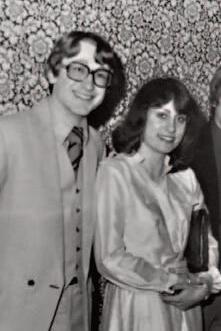

WE have been delighted to welcome two new members, Alison Grant of Fenay Bridge and Carl Burgess of Dalton; and we also welcome back a former long-standing member with whom we had lost contact, Christine Shaw , now living in Meltham. However, we have been saddened to learn of the recent deaths of Peter Ashton (195055), of Almondbury, Keith Bottom (1948-53) of Brighouse and Stephen Hoy (1962-67) of Holmfirth.
Subscriptions for 2021-2022 fell due on 1st September. Most of our members now pay their subscription by standing order, which makes life easier. If you are one of the few who do not pay by standing order and you have already sent your
£10.00 subscription for this year, thank you very much for being so efficient!
If you do not pay by standing order and you haven’t recently made a payment for this year, then you will receive a letter with this magazine pointing out that your subscription is not up-to-date. In this event, please send your payment without delay. As I mentioned above, it does make life much easier if you pay by standing order so, if you can complete the updated standing order mandate that accompanies the letter and return it in the envelope provided, that would be even better! Alternatively, you may renew online, using PayPal or a debit or credit card, by visiting www.oas.org.uk and clicking on the ‘Join/Renew Online’ button.
See page 59.
ANNUAL GENERAL MEETING
Monday, 4th January 2022 at 7.30 pm.
See announcement on page 37.
Executive Committee meetings are usually held on the first Monday of the month. Due to Covid-19 restrictions, they have for some time been held virtually by Zoom at 7 pm, which means that members who are usually unable to attend have been able to participate.
In October, we reverted to meeting in person at School, in the ODH at 6.00 pm. However, we are trialling the continuation of the Zoom element so that more distant members can continue to be involved. Any member of the Society who would like to attend one of these meetings, either in person or virtually, will be made most welcome on the following dates:
Monday, 1st November Monday, 6th December
If you would like to join us via Zoom, please e-mail the secretary at andrew.haigh@oas.org.uk to request login details.
Covid has continued to present many challenges, not helped by a plethora of conflicting guidance. But despite everything our KJS cohort continues to perform well, reports
IN my last contribution to The Almondburian, I berated my own lack of foresight regarding Covid; one might even say that I, like everyone else, lacked 20-20 vision regarding the ensuing pandemic. I have already previously reported on the seemingly never-ending barrage of directives from the Department for Education (DfE, particularly in the early days of lockdown.
My claims have now been substantiated by a recent University of Cambridge and University College London study, in which it described how teachers across England were overwhelmed by a “ridiculous blizzard of rules and documents, alongside major announcements made through the media or press conferences”. Researchers found that the DfE issued more than 200 pieces of guidance in the first 90 days of the pandemic, including a dozen days when the department issued at least five separate pieces of guidance. Multiple documents often called for immediate action, with some arriving at weekends or at night, creating a minefield of confusing or overlapping advice, which was sometimes contradicted by other statements or updates from the DfE and various arms of the gov-
Ian Rimmernew policies were sometimes announced to the public before official guidance had even arrived, “so parents were on the phone before heads even had a chance to read it”.The study also found that the DfE caused problems by failing to clearly show which parts of a policy or guidance had been amended when it made changes, with more than 70 new policy documents each being updated three times on average. “Leadership teams literally had to print off different versions and go through them with a highlighter, usually in hastily organised meetings at 7am”.
Unsurprisingly, over time, senior colleagues and I became exhausted trying to understand and then implement reams and reams of highly technical and detailed guidance. Along with other headteachers, I craved clarity and certainty so that I could lead my whole school community decisively and safely. Instead, the ever-changing advice from the DfE leached away at our confidence and organisational ability.
The real low point came at Christmas. After delivering a superb service during the autumn term, heads were then told on 22nd December that they were now responsible for mass student testing for the start of Jan-

‘…a ridiculous blizzard of rules and documents, alongside major announcements made through the media or press conferences’
uary. Colleagues and I worked throughout the holiday period trying to prepare for this huge task, which carried significant responsibilities in terms of keeping our staff and students safe. We were ill-equipped to do so and often learned more from social media and news leaks than from the DfE itself. After a draining period, the first day of term came and then the DfE and government changed its mind again.
Of course, nobody underestimates the scale of the challenges faced by ministers and civil servants but schools were given a very raw deal by the DfE. On 15th September 2021, we heard that the Secretary of State for Education, Gavin Williamson, paid the price for this and other recent fiascos, by being removed from post. Let’s see what our new Secretary of State, Nadhim Zahawi will bring us. At least his recent successes with the vaccine roll-out may offer us a little encouragement.


As most readers will know, GCSEs this year were awarded on Teacher Assessed
Grades. I am delighted to report that, as a result of very thorough processes building up to the submission, that all our grades were accepted. That meant that results day was not much of an event or a surprise. Our fantastic cohort achieved a Progress 8 score of +0.96, meaning that on average each student was nearly one grade above expected progress in each of their subjects. Within that figure English Progress 8: +0.73, Mathematics Progress 8: +1.01, Ebacc Progress 8: +1.18, Other Progress 8: +0.85 This represents a positive performance for students on average in all subject areas.
In addition to all the Covid-19 problems, the past few months have provided us with plenty of other to occupy our thoughts. Site development has continued (in some cases at least) apace over Summer. The new teaching block at the back of the School (see overleaf) is still just about on schedule to be completed in December, paving the way for ourYear 8 students to move down to the St
Helen’s Gate site from their temporary home at Fernside.
Internal works have also been progressing but not without hiccups. The Café (former Common Room of various descriptions, I believe) was found to have been constructed on unstable foundations, which has delayed the work in that area. Also, the oft-publicised international shortages of key materials and (Covid-related)
Top: New teaching block at the back of the School
Middle left: A classroom has been converted to provide additional dining space; the present dining room has also been refurbished
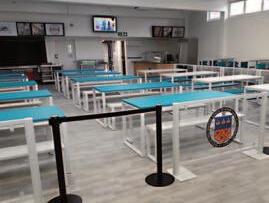
Bottom: A new science laboratory has been created by converting a former common room
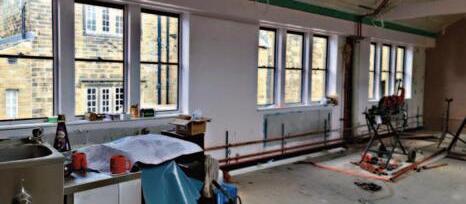
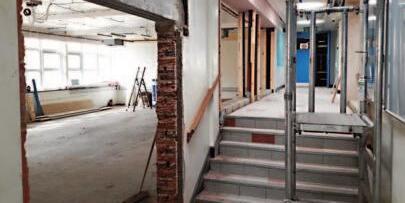
labour issues have meant delays. Hopefully all should be completed by October halfterm, a mere seven weeks after the original completion date.
So, what of 2021-22?Well, let’s hope that it is a little less eventful.We look forward to the completion of building work on the site in January and Year 8 joining the rest of the School down at St Helen’s Gate.
And then it truly will be Floreat Schola! n

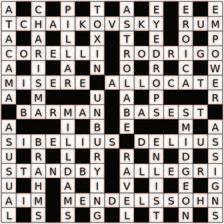

Entries to the Editor (address/email: back cover) by 31st January 2022. Prize: 12 months’ free OAS membership
l The winner of Crossword by Hérisson (July 2021) was Kim Dyson (1968-75)
1. Feste only 60% there. Drawback for Malvolio, maybe. (7)
5. First man, a six-footer, is determined. (7)
10. Tweeter found in briar, oddly, close to wood. (4)
11. Parmesan,perhaps. Bad luck. (4,6)
12. Expand opening of Edinburgh Castle, a ruin. (8)
13. Middle Eastern country holds leading Saudi sycophants! (3,3)
14. They’re on door sign he altered. (6)
16. Artisans manufactured rulers. (8)
19. Attach nine. Goes at the end. (8)
20. American fuel mix is effective.(6)
21, 27. Acquired bad actor, Chester, for example. Where you might find the Caped Crusader. (6,4)
24. 10 – communist institute. (8)
26. Release inmates from here? (4,6)
27. See 21.
28. A match for the devil! (7)
29. Break the law before day’s end. That’s rich! (7)
2. See 18.
3. Overheard asking for reason to suspend lens. (4,5)
4. Ran through Ed Sheeran. Endlessly corrupt – about right. (9)
6. Precedes 10 – not safe. (5)
7. Encounters hunts. (5)
8. As fortune became mixed, he sought blood! (9)
9. Align, say, train. (6,7)
15. Hérisson’s on time, unusually first and not 4. (9)
17. Benaud can spin a great deal! (9)
18,2. Organise titanic swindle for sharers of DNA code. (9,5)
22. Laugh in disbelief at language penned (5)
23. Come out, lose head and join. (5)
25. Heave and extend. No way! (5)
Despite all the pressures caused by Covid-19 I still love my job as an Assistant Principal, says Abbi Terry. I’ve been asking myself how that can possibly be.
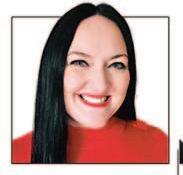
Iwould argue that out of all of the Senior Leadership roles at King James’s School, mine is the best. I believe that I have the best job in the School and there are many different reasons for this:
1 . I have the most positive role! I have been given responsibility for student rewards this year which is very exciting. We already have a successful robust system of rewards in school but I want to see how we can reward our amazing students on a smaller scale, for example, for random acts of kindness or for going above and beyond expectations. A student this week spoke to me about how he buys breakfast for one of his friends because he doesn’t have anything to eat at home. While this is heartbreaking in itself, the fact that this student is prepared to look out for his friend is incredible.
2 . I am part of a group driving positive change at School.
Following on from the revelation of the student, I spoke to different members of staff and the response from them was heartening. This reminded me once again that our staff don’t just work in education because its simply a job. They do the job because they care and
want to make a difference to our young people and to our community.
3 . I work with outstanding students.
Part of my role includes coordinating student leadership across the School and this includes Senior Students, Student Council, Student Wellbeing Champions and other student leadership roles. I attended the Year 7 welcome assembly by Mr Rimmer in the first week back at School and he spoke about wearing the King James’s badge with pride and it is clear that our students do exactly that. They are proud of the School and they want to keep the school moving forwards so that we can continue to be bigger and better all the time.
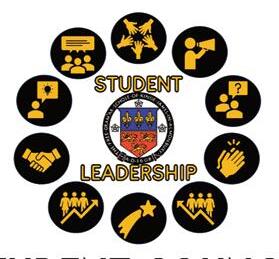
4 . I lead on Post 16 transition.
Our close relationships with local colleges and local apprenticeship providers means that we are able to keep up to date with how the majority of our ex students are doing. This has been hampered somewhat by the changes in law regarding General Data Protection Regulations (GDPR) and the information that can be shared unfortunately. Previously, the colleges
continued on page 12
I’m conscious that my article mentions a number of terms that may be unfamiliar to some readers. So here is my guide to education today, KJS-style.
We encourage students take developmental responsibility in School. For example, our Student Council represents student voice and is consulted on for many issues. Science Leaders support the science department and students who are struggling in the subject, while Sports Captains support the PE department with their clubs and activities.
Students earn ‘achievement points’ for doing what is expected of them. For example, they may be ready-to-learn students who arrive, get out equipment and are all readyto start; students who make an excellent contribution in lessons; or ‘model’ students who have worked hard throughout a lesson.
No school today can afford to rest on its laurels and that includes King James’s School.There are so many key issues of importance, especially to our young people; for example, climate change, mental health, pupils who are disadvantaged and struggling, and so on.The School is their community and the students want to lead change to make things better for themselves and each other.
Members are form representatives (two per form). Sometimes they are voted in by the form and sometimes they are selected by form tutors.Ther are three stages:
Week 1: Form-time discussions. Examples: student responses to the new 5 period / 2 week timetable; reactions to the new dining room; reactions to the new toilets; how to deal with litter.
Week 2: I meet the Council to discuss key points from the different form groups. A sub-committee also meet with the Senior Leadership Group to discuss key concerns and ideas.
Week 3: Student Council members report back to their form groups.
Selina Sylvester, our Wellbeing Mentor who is a trained counsellor, trains around 25 Year 10 students to become Student Wellbeing Champions following the Mental Health Foundation Peer Education Programme.They are trained in the basics of mental health: what is mental health, how can we look after mental health, what can you do if you are struggling and so on.They then go into Year 7 form time over a 5 week block and teach the students about how to look after themselves. This will be our third year of running this programme and the outcomes have been amazing with Year 7 students saying that it has helped to demystify mental health issues.
What happens to our pupils when they leave King James’s School for further education. Sadly, our feedback is hindered by current GDPR regulations.
This refers to lunchtime and after-School clubs, groups and activities, as well as visitors in School and student visits out of School.These activities have been hit hard by the pandemic but we are now trying to improve our enrichment opportunities for our students. Current clubs and groups include learning Ancient Greek, watercolour painting, an LGBTQ+ group, a chess group and adiversity group, 11
would be able to tell us about the next steps of our students but they are no longer able to do that and so now we often reply on our ex-students themselves letting us know. This week we had our Open Evening for potential Year 7 students and two of our ex students also came along to see staff and to see the changes happening at the school. I spent a while chatting to them and was incredibly proud to find out that they are doing fantastically well in their respective careers at Cummins and in the IT department at Kirklees Council.
5. I lead on enrichment.
Last but not least (for this issue!), it is my job to facilitate all of our enrichment opportunities for our students. This
week we were incredibly lucky to be able to welcome Rachael Dodgson, a Senior Education & Engagement Officer at the House of Commons, to talk about how democracy works in the UK. Students were able to ask her questions which included: Do you know Boris Johnson? (answer: not personally, no, but I do see him at work); Have you met the Queen? (answer: yes, I have); Who do you vote for? (answer: I do vote but I don’t share who I vote for because I have to be neutral). Students later said that they thought politics were boring and nothing to do with them but after Rachael’s visit they have changed their minds.
This is why I am incredibly lucky.

WE’RE expecting a very large attendance at this year’s Annual Dinner, following the postponement of last year’s event because of the continuing uncertainty around the Covid-19 situation. The Dinner, which will also mark the Centenary of the Old Almondburians’ Society, will take place on Saturday, 20th November at 6.30 pm for 7.30 pm.
The speakers will be diplomat, poet and author David Morphet (1951-58) and former teacher Bob. Field (1973-89).
Richard Teale is organising a sixtieth anniversary reunion of the Class of 1961 and
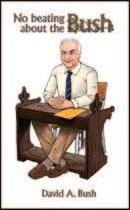
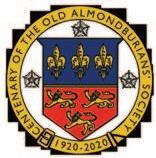
Dawn Smart is organising a forty-fifth anniversary reunion of the Class of 1976. It’s not too late to get your order in NOW. The ticket price is £29.50 and an application form for tickets is included with this issue of the magazine. Alternatively, you can purchase tickets online at www.oas.org.uk/buydinner.php. Please be aware that when the dinner is held at the School, places are limited. Tickets are already selling well, so please apply quickly if you have not already done so. Of course, the tickets which had already been purchased last year will be valid for this year’s dinner.
A special guest at this year’s Annual Dinner will be former head of Latin and Deputy Head Dave Bush who will be travelling up from his home in Porthcawl to sign copies of his book No beating about the Bush.
Informal tours around the School will be available before the Dinner.
In order to enable greater participation by pupils from the School, the traditional Founders’ Day Service will this year be held on the afternoon of Friday, 19th November at All Hallows’ Church, Almondbury.The procession up St Helen’s Gate will leave the School at 2.00 pm.
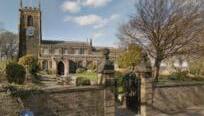
Don’t delay – tickets are going quickly!
David Morphet left KJGS to gain a Double First in English at Cambridge. He entered the Diplomatic Service in 1961 and in due course became a private secretary to Michael Stewart and George Brown.
Later he moved to the Department of Energy and was later seconded to Midlands Electricity Board as deputy chairman. He also held senior positions in Balfour Beatty and BICC. Following the privatisation of British Rail he led the Railway Forum.
Today, David is best known as one of the UK’s most highly respected poets.
A graduate of Hull University, Bob Field gained a degree in French and German in 1972.
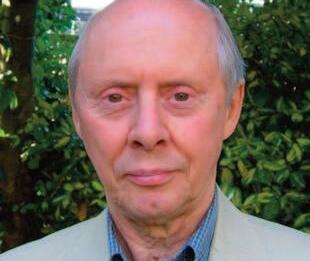
He came to KJGS in 1973 to teach French with Dave Gregson, later moving to Greenhead to teach French and German.

A keen sportsman, Bob took over the coaching responsibilities of the KJGS First XI football and generally assisted sports master Ken Ireland. He organised the staff football and cricket teams and was instrumental in the formation of the OAS cricket section.
As we go to press, the Almondburians below have already confirmed their plan to attend.
Surname
Beaumont
Broadhead
Brook
Burrie
Bush
Cunningham Caroline Guest Taunton
Cunningham David M. 1961 1969 Taunton
Dowling Roger 1952 1959 Lymm, Cheshire
Dyson David M. 1968 1975 Oakes
French Andrew Peter 1968 1975 Durham
Haigh Andrew Mark 1977 1983 Almondbury
Hey Richard 1951 1957 Lepton
Honeywell Ruth J. 1979 1981 Guildford
Law George 1951 1959 Fenay Bridge
Kirby R. Andrew 1961 1967 Almondbury
Kirby D. Ian 1961 1967 Dalton Lawson Hugh 1954 1961 Sheffield
Leake Prof. Robin E. 1954 1960 Glasgow
Livesey Barry 1953 1960 Sheffield
Lofthouse Howard John 1952 1959 Sheffield
Milnes H. Graeme 1957 1965 Cardiff
Morgan Paul B.A. 1954 1963 London
Openshaw Marilyn Guest Ellesmere Port
Orme Dr. Les. J. 1961 1968 Shepley
Oughton Richard Donald 1966 1967 Norwich
Raleigh Walter Staff Almondbury
Reid Reverend M. Pat Staff 1975 1997 Lanchester
Royle Prof. Edward 1955 1962 Leamington Spa
Sanderson Peter Graham 1961 1966 Stockport
Sharp John Franklin 1951 1958 Leighton Buzzard
Shaw Emily 1997
Shaw Stephen Matthew 1995
Shaw Christopher Mark 1993
Shaw Christine E. 1974 1976 Meltham
Smith D. Melvyn H. 1961 1968 Chelmsford Smith John Oswin 1957 1965 Saffron Walden
Talbot Paul Robert 1963 1971 Dartmouth
Taylor John Richard 1954 1962 Ossett
Taylor Dennis 1961 1969 Chesterfield
Taylor Dennis (guest) 1961 1969 Chesterfield
Taylor James Andrew 1963 1970 Bidford-on-Avon
Teale A. Richard 1961 1968 Thongsbridge
Walsh Steven 1961 Almondbury
Ward J. Andrew 1957 1964 Slaithwaite
West Sandra Staff 1981 1990 Slaithwaite
West Christopher J. 1960 1966 Slaithwaite
Wilkinson Leslie 1954 Brighouse
Wilkinson Leslie (guest) 1954 Brighouse
Wood Martin J. 1961 1969 Skipton
664 ET . What a strange way to open my latest Farnley Lines ! To some it will have meaning while for others it will be a complete mystery.
Let me explain. I have recently changed our car. After many years of Toyotas, a Kia now sits on the drive. To be more precise it’s a hybrid Niro 4 in ‘Runaway Red’. Who thought up that name? Its gimmicks and gadgets appear limitless and quite beyond a technophobe such as I. I have indulged somewhat as it has a seven year guarantee, numerous safety features and could well be my last car. Reality must be faced head on.
 DAVE BUSH
DAVE BUSH

How can I justify all this detail in an article for The Almondburian ? Patience, please for the registration number has a King James’s connection. When I do cease driving, son Alan has already laid claim to it as a family heirloom.
All its extras led Margaret and me into reminiscences of our travels to Spain in the late ’60s. For example, one year we drove from Huddersfield to Isla Cristina near Gibraltar in August; no seat belts, no power steering, no air conditioning, keeping comparatively cool by wrapping wet towels around our necks, nightmare, especially at night, three lane highways in Southern France and two young ‘are-we-nearlythere-yets?’ in the back. Not content with having reached the most southerly place in Europe we crossed over with our Spanish friend into the Spanish enclave of Ceuta and on to Tetuan in Morocco. And then … all the way home again.
Besides our annual trips to the Iberian Peninsula, around this era there were two
School trip to Italy, April 1968, left to right,
Back row: J Turner, A C Phillips, P R Wood, D J Rothery, M Taylor, R W Johnson
Row 2: J R Stafford, S M Taylor, D J Sykes, J M Stafford, D G Rhodes, S Frost, J S Fitton, R K Brown, D Brook
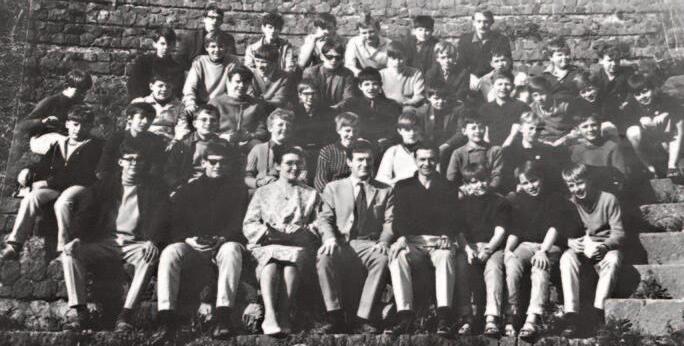
Row 3: A Currie, A Esslemont, S B Sykes, N Hayes, P Edson, P D Gelling, S Burns, J L Smith, G S Sellens, M Grant
Row 4: P Brook, M Torczynowycz, M Lofthouse, J Oldham, C Beecroft, A Lloyd, P Nunns, M J Warwick, M Kain
Front row: J T Harlock, I Smith, Betty Toomey, Jim Toomey, David Bush, A Cliffe,T Cliffe, R E Newsome
memorable journeys taking King James’s pupils to Europe. One involved travelling by coach and sleeper via Paris to the Spanish Basque country. Margaret and I joined Francis and Joan Bareham in organising this venture which saw Andrew Taylor purchasing blood-stained banderillos – the barbed darts plunged into a bull’s neck – after attending a corrida in St Sebastian. I believe he also told his parents that the Channel crossing had been rough when the traditional millpond would have been more accurate.
The other journey was even more adventurous. Some 45 pupils, aged 11 to 18, from Huddersfield to Florence, Rome, Sorrento and Capri by coach, train and boat! Some undertaking especially as there were only three lead -
ers: Jim Toomey, his wife Betty and I. Betty was heavily pregnant and Jim informed me at Calais that this was his first time outside the UK. If all these experiences are added to my numerous birding trips to exotic locations it has been suggested that there is probably a book in there.
O yes, 6664 ET. (Sorry to keep you waiting. Thank you for your patience. Your reading of my article is really important to me ). It began when yearletters were introduced on vehicle registration plates. I was not enamoured by having my car dated so decided to seek an old number on a scrapped car. This was at the time when King James’s was becoming a Sixth Form College. Among the students was John Clay from Bradley whose father had a scrap yard on
King’s Mill Lane. It cost me £5 to secure the number. (‘ET’, by the way, was a Rotherham registration). No real significance except that the film of that name added perhaps to its value. The ‘Twigmobile’ as it was known by pupils was never vandalised despite that fear when I left it around town.
I am indebted to Bob Field for the background to John Clay and for relating the story of Ricky Stocks. Bob was, and still is, a much respected football coach and his reputation ensured a number of talented footballers came to KJ from all over town; Ricky was from Deighton as was Steve Walton. Apparently, while refereeing a first team match, I had occasion to send Ricky off for some misdemeanour – Bob cannot remember what although he suspects, knowing Ricky, it was probably for ex -

cessive verbals – whereupon he sprinted to the changing rooms but found them locked. Undeterred he proceeded to clamber through an open window, grabbed his clothes and ran home to Bradley. He subsequently apologised both for being sent off and leaving the scene of the crime. He was a member of a very successful King James’s side as these recruits gave a certain street cred to a team which had been considered something of a soft touch until then. As I wrote these lines, it did cause me to reflect if this short but significant period in the School’s history is sometimes overlooked. Perhaps they may stir some former Sixth Form College student or students to offer some personal reflections on their time down St Helen’s Gate.
Back to the present with a bit of a
bump for I am writing this on the very day our local schools begin their Autumn Term. How I feel for them! Continuity and routine are essentials for successful teaching and learning. Enforced change of teacher, movement to an unaccustomed room, unusual weather, anything that breaks the pattern has a detrimental effect on a pupil’s assimilation of knowledge. The past eighteen months have, to state the obvious, been a nightmare and not just for the pupils. Teachers and particularly those in senior management have been under enormous pressures to maintain some semblance of normality. Add to this the farcical situation over exam results. Sorry but that’s how it appears to many. ‘Why not give everyone an A* in everything?’ suggested a neighbour. I have some sympathy …
ahead this time. Its postponement last year did have one advantage on a personal level for it means that it is now 25 years since my retirement. When my book was published it received particular acclaim from my last Latin group and others who left King James’s around that time. A great gathering was planned and many committed themselves to attending. I do hope their enthusiasm has not waned for it should be a great occasion. I shall be signing the remaining copies of my book so if anyone wants a first edition then it can be reserved (such delusions of grandeur!) ‘Little Miss Nose Stud’ has proved quite a star being so frequently mentioned in its pages; I do think every effort should be made to track her down and invite her to the dinner.
As always, let’s try to finish on a positive note. For the first time in more than eighteen months we are having a face-to-face twinning committee meeting and then, glory be, later that same week badminton resumes. There are some restrictions and requirements but they will not deter Viv, our oldest member, who at ninety and a half is rarin’ to pick up his racket. Overseas birding trips, however, seem a long way off both metaphorically and literally.
Then there’s The Great Celebratory Dinner in November. Surely it will go
The Department of Education has announced a £4 million project to ‘roll out the teaching of Latin in state schools as it begins a drive to ensure the subject is not just reserved for the privileged few’. Fine in theory but difficult in practice. Where are all the required Latin teachers to
Wheeled out, probably literally, from retirement? It’s a long commute from Porthcawl to Almondbury. Perhaps a local secondary school would welcome my presence? However, a glance in the mirror suggests the pupils might think I was a contemporary Roman. Stick to the allotment! n
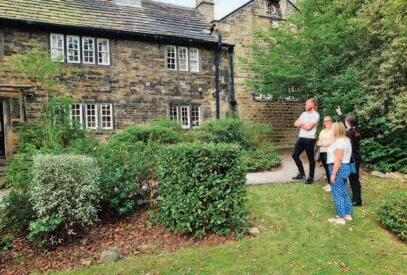
King James’s School again takes part in national ‘Open Days’ event

AFTER a break of a year because of Covid-19 there was great anticipation for the opening up of King James’s School once more for the general public to look round.The occasion was the national Heritage Open Days event on 18th September to celebrate the country’s history, culture and architectureAt these events there is also a feeling of trepidation. Will anyone actually turn up and take advantage of the School being open?
We need not have been worried. As the team of 16 wonderfulYear 10 students were receiving their final briefings on the Headmaster’s lawn, a full half hour before the official opening time, we were joined by our first visitors and that is an indication of what the rest of the day held for us.
We opened at 10.00 am and closed at 2.00 pm and there was a constant stream of eager visitors wanting to look round and learn something of the history of the old School. In all over 50 adults together with numerous children came to visit us.After last year’s cancelation we were delighted with these numbers. The bright sunny weather helped
the atmosphere as visitors began the tour in the garden and then walked through School visiting the Old Dining Hall, the Head’s Study, the Big and Small and finally, on the ground floor, the social area which contains the Timeline of the School.This feature alone kept the guests fascinated as they saw this portrayal of the rich history of the School over the past 400 years.
The theme of the 2021 Heritage Open Days event was ‘Edible England’. Walter Raleigh recalls the School’s wartime efforts during WW1.
MOST of us are aware of the Battle of the Atlantic in the Second WorldWar.This was the attempt by the fleet of German U boats to stop food and armaments getting to Britain from the USA and Canada. It was a successful campaign which led to numerous shortages in Britain and wide scale rationing of food. It also led to the loss of thousands of sailors who went down with their cargoes.
Fewer of us realise that this was a repeat of what had happened in the FirstWorld War. The German fleet tried to blockade Britain and stop supplies getting to us from the colonies of Canada, Australia and South Africa.And again it was very successful so that by June of 1916 we only had six weeks supply of wheat in the country. Possible starvation loomed if food could not reach us before the harvests.
In both wars people turned their gardens over to food production.Those without gardens had land provided for allotments.All were ‘digging for victory’.
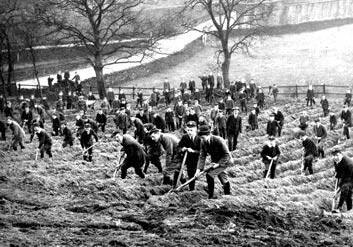
And King James’s Grammar School, or Almondbury Grammar, as it was known then, played its part in preparing for war. A School
Cadet Corps was formed and over half the boys joined with regular route marches and shooting as the main activities.
The School numbers in 1914, at the start of the War were 108 with 10 boarders. Parents saw the School as a safe haven so that by 1918 there were 190 on roll with over 30 boarders. But these larger numbers needed feeding so in 1915Taylor Dyson decided to ‘dig for victory’. He organised the boys to dig the area known as ‘the bunk’ so that vegetables could be grown for the boys to eat. This area spread from the BigTreeYard down the hill to Arkenley Lane.The bank is still there but the field at the bottom is now a staff car park.
We have no figures for production of potatoes and other vegetables but we know it was a successful venture with all the boys involved everyWednesday afternoon.Taylor Dyson tried to introduce some competition when harvesting the crops as he put House teams against each other but we are told this failed miserably when boys, rather than proving they could gather more than the other Houses, spent time sabotaging the efforts of others by throwing potatoes at each other.

Almondburian: How did you become a pupil at King James’s School?
JH: It was purely geographic – we lived at Lepton which was of course in the KJS catchment area. I could – and often did –walk to School as it was only a brisk 30 minutes away.We were the first comprehensive intake, in 1976, and I was 13.
A: How did you and your friends feel about going to KJS?
JH: I think we were quite excited, actually! It was a much more formal school than we were used to at Lepton, with teachers like Mr Conley and Mr Bush wearing gowns all day!
A: Looking back, did you enjoy your schooldays?
JH: Yes, I was very happy there. I liked most subjects, perhaps more on the arts side than the sciences.
A: Were you keen on sport?
JH: I enjoyed sport though I didn’t especially excel! I do remember those awful cross-country runs, with the PE mistress Mrs Ainsworth tooting her horn at us as she drove behind us in her Mini up Arkenley Lane. On one occasion we took a crafty short cut and were caught and made to go round again. But another time I told her I thought I wasn’t feeling too well so she gave me a lift back in her car. A triumph!
A: Which teachers do you recall?
JH: I’d particularly like to mention Mrs
[Frances] Walshaw, who was a History teacher during my time at King James’s. She was a great teacher and a true female role model for me, and I was delighted to see her again at an OAS dinner a few years ago.
A:The School still had a sixth form in those days. What did you study?
JH: I took ‘A’ levels in French, English and History, leaving KJS in 1981.
A:Where did you go to university?
JH: I went to Nottingham, which also happened to be my father’s old university. I graduated in Social and Economic History
A: After graduation, where did you go next?
JH: I joined the Civil Service, initially as an Executive Officer in the Home Office.The interview was in Leeds and I remember I was asked to discuss the pros and cons of the death penalty. No doubt that’s why I ended up in the Criminal Policy Department! Then, in 1987, I had a gap year when I travelled around Australia and the Far East.
A: Did you continue to work in this area when you returned?
JH: Yes, over the following years I worked variously in Police Department Policy, Prison Service Security and Criminal Policy. Outside work, I was also an active school governor for many years.
A: When did you move into Human Resources?
JH: In 2001. I had various roles in the Home
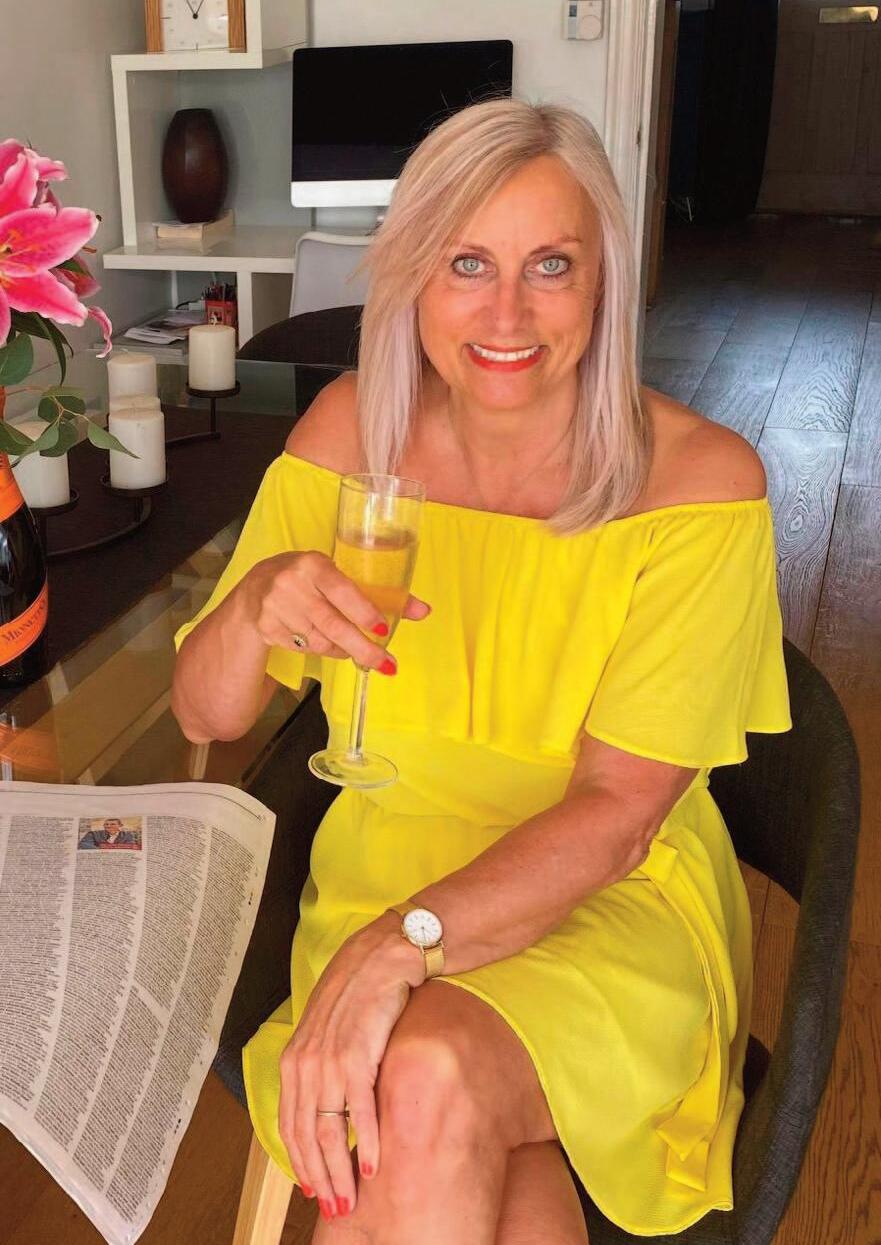
Office HR Department, after which I became Senior HR Business Partner in the Department for Business. I became Head of HR for UK Trade and Investment (UKTI) in 2013 and when the new Department for International Trade (DIT) was formed in 2016 I took on my present role as HR Deputy Director.
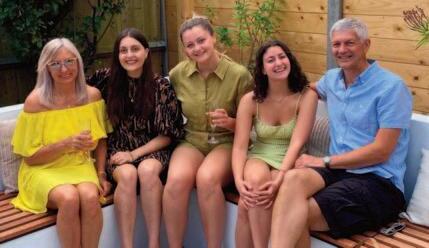
A: You’ve had a very varied and challenging career in the Civil Service!
JH: Yes, very varied indeed. To give you an idea, while I was working in Prisons and Criminal Policy I led on the reform of laws relating to rape, homosexuality and the protection of minors, and encountered some of the most violent criminals in the country. The work included managing the operation of special secure units while supporting where possible criminal rehabilitation.
At UKTI we secured a global Investors in People accreditation. We also launched the department’s first assessment against the Stonewall Index, a list that showcases the best employers for Lesbian, Gay, Bisexual and Transgender [LGBT] staff.
A: Since 2016 you have had a top role in the DIT. What has your work as Deputy Director involved?
JH: As a member of the HR Executive Team, I was involved in setting up this new department of state headed by Secretary of State Liz Truss*.The headcount increased from 2,500 to nearly 5,000, so it was a big
HR challenge. We introduced a new regional People Plan for our 1,300-strong overseas workforce which has resulted in the highest LGBT and BAME (Black, Asian and Minority Ethnic) representation in the Senior Civil Service.
A: How have you been affected by the Covid-19 pandemic?
JH: For a start, I’ve been working largely from home. That’s ironic as we now have beautifully refurnished offices in the Old Admiralty Building overlooking Horseguards Parade in Westminster! But more importantly, we’ve had to work long hours to repatriate diplomats and other staff from abroad. It has been particularly challenging because many of these staff had no homes or other accommodation in the UK. Many also needed help finding schools for their children. And more recently we’ve had the same issue in reverse – getting the staff and families back to their bases abroad.
A: What has your honour meant to you personally?
JH: As a woman I am particularly proud to have received the OBE and have been struck by the attention it has received, particularly from my three daughters and their friends. I hope that in turn I can become a champion and a role model for other women to achieve their potential and to be recognised for their achievements, including perhaps current students at King James’s School! n
years ago, our lives changed forever when Britain abandoned pounds, shillings and pence and introduced decimal currency.
The humble penny dated back to the seventh century and was based on the concept that 240 pennies weighed one pound in weight. A pound coin did not appear on the scene until 1489, during the reign of Henry VII, taking the form of a magnificent gold sovereign deliberately intended to convey the strength and majesty of the new Tudor dynasty. The shilling, worth 12 pennies, had appeared slightly earlier.
Over the centuries, further coins such as the farthing (a quarter of a penny), the halfpenny or ha’penny, the florin (worth two shillings), the half-crown (two shillings and sixpence) and the crown (five shillings) were added.
It became a hugely complicated system and it is remarkable that it survived until 1971 when Edward Heath’s conservative government took the decision to introduce decimal currency based on 100 new pennies to the pound.
As one would expect, the momentous change was noted by one of The Almondburian’s poetic contributors.
Decimalisation will change our lives, Or so the experts say: The youngsters will be saved the plight Of doing £.s.d sums all day.
The new copper coins have a better weight, Or so the experts say: But so long as they buy things I couldn’t care less what they weight.
Decimal prices can be cheaper Or so the experts say: But I wonder if they really know The prices the public pay.
K C Dyson,3ATop: The old penny traditionally showed Britannia on the seashore holding a trident, with a ship and lighthouse in the background. Pennies minted between 1860 and 1894 were known to smutty-minded schoolboys (in other words, ALL schoolboys) as ‘Honolulu’ pennies on account of the unfortunate positioning of the trident; it was subsequently re-positioned on Britannia’s knee.
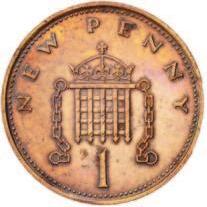
Bottom: A present-day penny. It was common practice in the early days to refer to it as ‘one pee’ to avoid confusion with the old penny. Many purists regret the continuing use of this vulgar term.
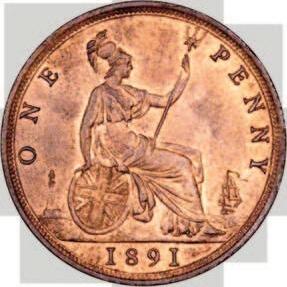
Fred Hudson was one of the School’s greatest-ever former teachers. In this article he describes in masterly fashion the geology of the Almondbury district and explains the origin of some of Almondbury’s oldest highways and byways.

THE Almondbury district is transitional in physical character, between the high, barren Pennine moors and mosses and the lower, less sterile plains of eastern England. Its elevation is modest but its relief is extremely varied: consisting mostly of undulating ground, steep slopes regularly giving way
to more level, plateau-like features. The whole area lies below 1,000 feet, and in the north, alongside the River Colne, a tributary of the Calder, falls to 200 feet. The older houses in Almondbury village are sited on one of the flatter stretches at the intermediate height of about 500 to 550 feet.

Archaeologically the oldest, but geologically the youngest part of the area, Castle Hill dominates the physical landscape. Even if stripped of its Jubilee Tower, it would still resemble an old friend, always standing up with a greeting whenever one returned from a journey outside Huddersfield.Though almost flat-topped, apart from the largely artificial mound at the south-western end, and by no means the highest summit in Kirklees or even in the former County Borough of Huddersfield, (it only just tops the 900 foot contour), it descends steeply, if unevenly down on all sides and therefore appears more mountainous than it really is. lts comparative isolation from other upstanding features makes it a superlative viewpoint.
From its summit one looks beyond three
of the bounding valleys of the ancient township and manor of Almondbury – those of the Holme, Colne and Rushfield Dike – westwards and southwards to the high Pennine plateau and its spurs, and northwards across the agglomerated buildings of Huddersfield to the fringes of the Bradford basin. On a clear day, were it not for omnipresent air pollution over Dewsbury and other built-up parts of theWestYorkshire conurbation, one could descry York Minster by turning one's gaze north- eastwards.Travelling more directly east, one would have to go as far as the Urals on the Asiatic border to reach a higher elevation.
The summit plateau of Castle Hill, including what archaeologists refer to as the prehistoric annexe beyond the north-eastern ramparts of the ancient fort, is composed of an outlier of Grenoside Rock (named after a vil-
lage near Sheffield). This is a yellowish, gritty sandstone forming the youngest bed of the local strata, all of which, apart from the Rough Rock of the topmost Millstone Grit series rising above the River Holme in the Berry Brow area, belong to the Lower Coal Measures of the Carboniferous period originally laid down about 300 million years ago.
The sides of Castle Hill, forming a steplike ‘cliff and bench’ type of topography, are formed of alternating beds of soft shales or mudstones and harder, fine-grained, greyish sandstones known collectively as Elland Flags. ln both the fairly recent and more distant past these flags have been widely quarried in the area both for paving-stones and vernacular buildings: for house walls where more massive, for roofing where more fissile. Wherever the flaky, easily eroded shales are exposed, gradients tend to be steep; the sandstones more often form shelf-like features whose gentle slopes conform to the slight eastern dip of the rocks. On the sandstones, field boundaries generally take the form of loosely constructed walls; on the shales they are mainly quick-set (hawthorn) or other hedges. Soils are drier, lighter and less acidic on the
sands, and the land is kinder to both farm animals and crops, though the proportion of arable land to pasture is very small, even on the flattest and lowest ground. Because of their heavy, clayey soils, which quickly become waterlogged in wet weather, but especially owing to their sharp gradients, many areas of shale are virtually useless for agriculture and remain under natural deciduous woodland. Besides being more desirable to the farmer, the areas of outcropping Elland Flags are also more suited to settlement than those based on shales, since the ground above them is flatter and drier. It is not, then, surprising to find Almondbury village and the neighbouring hamlet of Thorpe resting on Elland Flags. Geologically older than the Elland Flags are other sandstones, less extensively distributed in our area, notably the 80 Yards Rock, another flaggy rock on which, for example, Lowerhouses, Longley and Hall Bower stand, and the Hard Bed Band Rock, a harder siliceous bed on which Newsome and Ashing Hirst (Ashenhurst) are built, Immediately above the Hard Bed Band rock is the thin Hard Bed Band coal seam which in the past has been worked for steam-raising and
FRED HUDSON, a 1st Class
Honours Geography graduate of Leeds University, joined King James’s Grammar School in 1935. Known to generations of students as ‘Soapy’, he progressively raised the status of Geography in the curriculum. He had a particular interest in physical geography in the context of the local environment, and he was a superb cartographer whose blackboard maps were works of art. He was the author of numerous well-regarded Geography text books.
Fred Hudson served under four headmasters and became a highly respected Second Master in 1953. Preferring teaching to management, he never sought to become a headmaster himself, though he would have been an asset in this capacity at any school. He died in 1993.
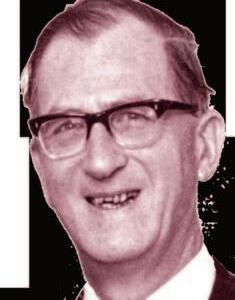
household use from shafts sunk between Castle Hill and Newsome.
Other coals, including the Hard Bed, Middle Band, Soft Bed andThin (Pot Clay) seams, are exposed towards the Colne and Holme valleys.They are divided from each other by much thicker shales and sandstones which form the bulk of the slopes descending by very steep scars to the broad. alluvial flats of the two rivers.The coal seams, rarely more than two feet thick, were formerly exploited for local use from shallow pits in such localities as Damside (near the Colne), Close Hill, Lady House and Cold Hill (above Berry Brow), and Lower Park (below Stirley Hill).
Both the Holme and Colne have their headwaters in the high Pennines. Most of the more local drainage courses, whether contributing their run-off to these rivers or to the less significant Fenay Beck on the eastern margin of our area, have their origins on the lower flanks of Castle Hill.Their sources are small springs at or near the junction of porous sandstone and impermeable shale.The chief stream is the Rushfield Dike, known in its upper reaches, where it threads Molly Carr Wood, as Lumh Dike. It gathers a number of small effluents from the eastern slopes of Castle Hill and from the extensive woodlands leading up to Farnley Tyas, and, twisting and turning as it goes, makes its errant way northeastwards in a valley which seems too large for its present inconsiderable size and suggests that it was once occupied by a more powerful river. Rushfieid Dike eventually enters the Fenay Beck close to Fenay Bridge, at about 240 feet, having fallen about 440 feet in 3 miles. Only below Rushfield Bridge (St. Helen's Gate) is its valley floor wide enough to carry much alluvium.
The short streams flowing northwards into
the Colne, now culverted in their lower courses, seem, in the impetuosity of their youth, to be in a great hurry to reach their destinations. The main ones are the Longley Hall Beck and its feeder Channel Dike, converging at the head of Squirrel Ditch, and the Penny Spring Beck and its tributary the Benholmley (or Benomley) Beck. Both the Longley Hall and Benholmley Becks rise at about 575 feet and join the Colne at about 200 feet; both flow through narrow ravines and they are bordered in their upper parts by precipitous and much-eroded, wooded slopes.
Until two centuries ago Almondbury, with its ancient church, market and wool industry, was a notable route focus. Several important highways, from east and south, met there, before descending to Huddersfield. Among these were two early turnpikes, which followed pre-existing lanes. improved when they became toll-roads, but not radically altered in direction:
Wakefield – Austerlands (on the county boundary near Oldham), authorised in 1759 and linking up with the older Manchester –Austerlands road by way of Almondbury, Huddersfield and Marsden;
Sheffield – Halifax, authorised in 1777 and serving Farnley Tyas, Almondbury, Huddersfield and Elland.
Not until the 19th century, when roads came to be specially designed and built for faster wheeled traffic, was Almondbury bypassed. Two of these new roads were valley routes:
the present Holme valley road (part of A616), turnpiked in 1809 to replace the older road (itself turnpiked in 1768) which
Right: The Ramsden Estate Map of 1634 clearly shows what we know today as Westgate and Northgate, with Almondbury Church, built 150 years earlier, on the corner.

rather more than nine inches to one mile, is still recognisable on the ground, though none of the ways is named on the map.The parish church (and, presumably, the market) and King's Mill (at that time the Lord of the Manor's corn and fulling mill) were the chief
the only settlement in Berry Brow.) Northwards, High Lane led into Jackroyd Lane, which continued beyond Newsome (which even then had its Towngate) over Newsome Common and down Lockwood Scar to Lockwood Bridge en route to Elland. A high-
way from Longley Hall followed Lowerhouses Lane, Dog Kennel Bank and Smithy Lane to Huddersfield Bridge, with a branch through Longley Park and Ashing Hirst (Ashenhurst) to King’s Mill.The latter could also be approached (by King’s Mill Lane) from both east and west.
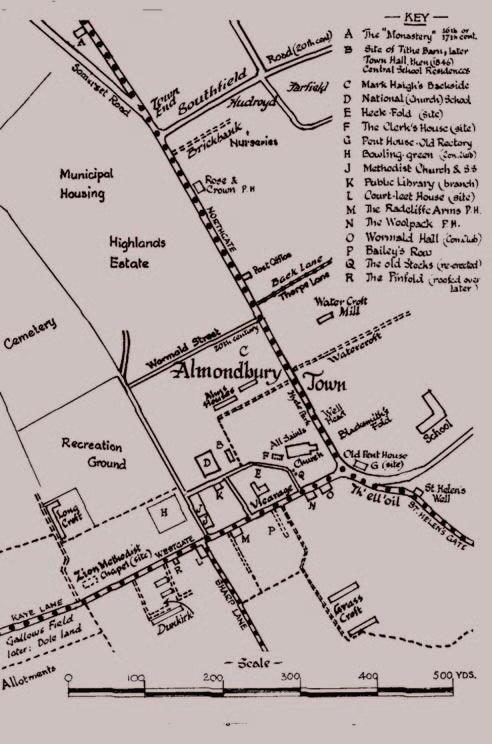
The way out of Almondbury to the north lay along Northgate and down Almondbury Bank to Huddersfield Bridge. Sharp Lane allowed travellers proceeding west to reach Lumb Head after crossing Almondbury Common and following Lumb Lane, while St. Helen’s Gate enabled them to make their way along Dark Lane to
Thorpe, whence there were ways along bothThorpe Lane toTown End and along Fleming House Lane to Quarry Hill and Oaks Hill. Birks Lane apparently terminated at Fenay Hall.
The names of the ancient highways indicated, but not designated, on the 1634 map form a subject in themselves.All that need be said here is that most of them are either descriptive (eg Ashes Lane, High Lane. Dark Lane), personal (eg Kaye Lane), or geographical, ie named according to the house or hamlet towards which they led (eg Lumb Lane, Lockwood Scar).These highways are variously referred to as ‘lanes’, ‘banks’, ‘gates’, etc, the word ‘road’ not gaining currency until the Turnpike Acts of later times were framed.
Many of the ancient ways, eg Sharp Lane and Lumb Lane, retain their ‘causeys’ (later corrupted to ‘causeways’), ie raised borderflagstones (of local Coal Measure sandstone) which a pack-horse could use in both wet and dry weather when the then sunken, unsurfaced carriage- ways might be muddy. deeply rutted, or excessively dusty. (The term ‘causey’ was also used of raised stretches for single large stones laid across low-lying land liable to flood and without any facility for wheeled traffic, and for broader ‘packhorse tracks’).
Among important long-distance highways
serving Almondbury from before 1675 was the road from London to Richmond (Swaledale), passing en route through Oakham, Nottingham, Rotherham, Barnsley, Huddersfield, Elland, Halifax, Keighley and Skipton. lt approached Almondbury from Shelley, Kirkburton and Dogley Lane, crossed Fenay Beck near Woodsome Mill, utilised the present Woodsome Road for about 200 yards, then turned off to the left along the now-unused path running due west and skirting Woodsome Hall on the north side. lt continued along a sunken way through Birks Wood from which it emerged in the Woodsome Road at the triangle above Rushfield Bridge. Having crossed this bridge it ascended St. Helen's Gate and
reached Huddersfield via Northgate and Almondbury Bank.
In I719 and 1720, John Warburton, road-surveyor and cartographer, recorded the highway connecting Sheffield, Penistone and Halifax. From Penistone, this route reached FarnleyTyas by way of Ingbirchworth and Shepley, then, after following the present course of the Woodsome Road for a short distance, diverged slightly to the left along what is now a field-path to reach Bankfoot Road (‘Red Bank’) below Farnley Bank. lt crossed Lumb Dike at Bank Foot Bridge and entered Almondbury by way of Sharp Lane before turning right along Westgate to join Ogilby’s London Road at the parish church.
Warburton also recorded the old highway between Wakefield and Huddersfield, which was to be turnpiked under the 1759 Act. It left the present A642 north of Lepton Church, and reached the township of Almondbury at Fenay Bridge via Highgate Lane and Cowmes Top.
A map of Almondbury published by Thomas Brook in 1844, notes that Westgate was then known in its lower part as Kirkgate, in its upper part as High Street; the upper part of St. Helen’s Gate is Hell Hole (still occasionally referred to in dialect as ‘th ’Ell ’Oil’), the middle part School Hill. Parts of the 19th century turnpike from Huddersfield to Honley and of the present Penistone Road are now mapped, but Somerset Road, Newsome Road and Newsome Road South are still to come.
Since 1844, of course, many new estate roads have also been added to the landscape.
*Extracted from Historic Almondbury/ Kirklees Libraries and Museums Service 1975.
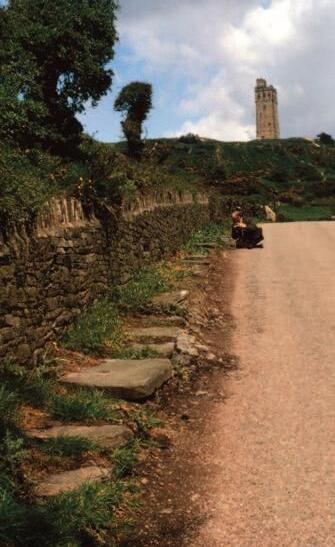
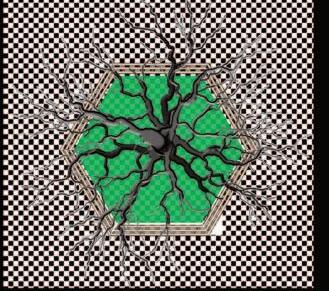
Every Almondburian who attended the School before 1997 will have fond memories of ‘Big Tree’ with its slatted seating that stood for years at the top of the bunk.To mark our Centenary, we plan to provide a replacement
IN our July 2020 issue, we announced our pledge to provide replacement seating around the base of an existing tree not far from the location of Big Tree, at a cost of some £5,000. We invited Old Almondburians to contribute to a fund to help with the cost and we’re delighted to report that we have already received nearly £600 from those keen to help. “I enjoyed the old tree!” wrote one member. “What a great idea! The tree was one of my first memories and one that has lasted. I sat on the seat so often and these happy thoughts stay with me,” wrote another.
The names of donors will be recorded on a plaque to be located on the base of the structure, and we are hoping that work will commence once the pre sent temporary classrooms have been removed early in the NewYear.
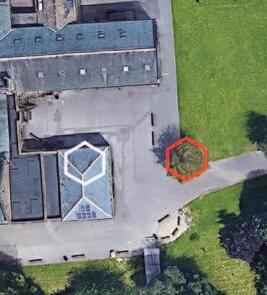
Donations can be made online at www.oas.org.uk/donate.php. Alternatively you can contribute by BACS: our account number (‘The Old Almondburians’ Society’) is 00814458, sort code 53-61-07. Please give your full name and mark your donation ‘Big Tree’. Alternatively, if donating by cheque please complete the form below and enclose it with your contribution.
To: Andrew Haigh, R D Haigh & Co, Oakhill Road, Brighouse, West Yorkshire HD6 1SN
Name Address
The hostility of the former headmaster of King James’s Grammar School towards the ‘professionalisation’ of his beloved rugby union –leading to the formation of Rugby League – inspired playwright MICK MARTIN to write his play ‘Broken Time’.
THE story of the desperate and illfated attempts by Rev Francis Marshall to maintain the ‘purity’ of his beloved Rugby Union was told at length by Walter Raleigh’s article in the November 2020 issue of The Almondburian.
Readers may be less aware that Frank Marshall’s activities inspired Bradfordborn playwright Mick Martin to write his successful play Broken Time which received warm reviews at its première in 2011.
Set in the fictitious town of ‘West Broughton’ (a device that enabled the playwright to bring activities over many towns to a single stage location), the play centres on the decision of wealthy mill-owner Herbert Dalton to bring a Welsh player Lewy Jenkins to the club to boost the club’s performance. He achieves this with the inducement of what was then an ‘illegal’ fee, plus a pub in which to live and to run when not on the field. An array of other characters includes fellow players and millworkers, George Wilkinson and Gil Gannon, agent Harry Stockwell and Lewy’s flirtatious girl-friend and stage-struck actress Bessie Butterworth.
The only character in the play who appears under his real name – and quite rightly so – is its central character Rev Frank Marshall. He has some splendid lines, and no-one could have any doubts about the sincerity of his convictions as he denounces the activities of West Broughton rugby club:
This game is the heartbeat of an Englishman’s character. Sport prepares young men for life ahead, service, duty, diligence and self-sacrifice.To serve and further the empire, bring Christianity and civilisation to the heathen far and wide.These are the values of all good schools.
…Make no mistake,we are fighting here for the soul of the game. No matter what form the payment to players might take, it is professionalism. It will destroy this game and leave us with nothing but a band of itinerant mercenaries who care nothing for the noble sport of rugby and everything for themselves and their own pocket.
It’s a great tale, all the more so being based around a controversial figure so well known to those who attended King James’s Grammar School; a man who, paradoxically, was also an outstanding teacher and writer who produced many school text
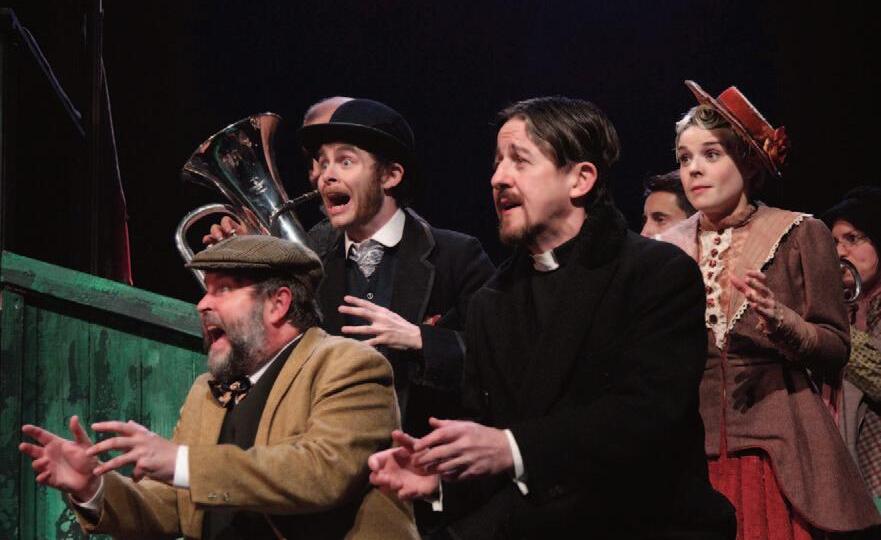
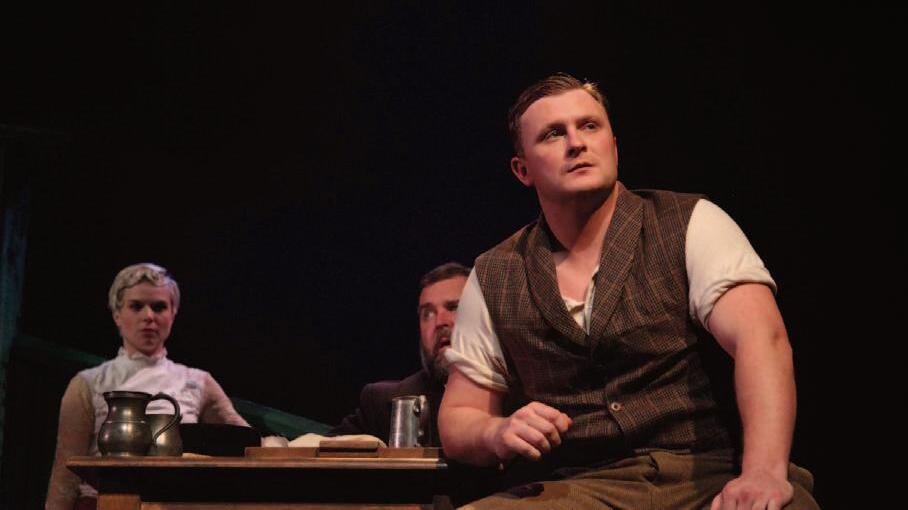
books about mathematics and the plays of Shakespeare. If he had not had such a fixation for the ‘purity’ of his beloved game, life might have been so different. But as we know, it all went wrong for Marshall as parents hostile to his views withdrew their children from the School. His career at KJGS came to a somewhat ignominious end in 1896 as he depart -
ed to take up a living in Mileham, Norfolk.
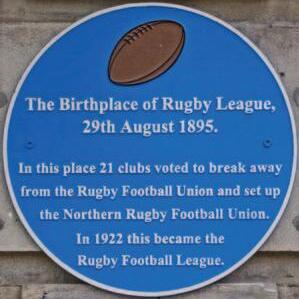
Broken Time was premièred at Theatre Royal, Wakefield in September 2011, followed by successful runs at Harrogate Theatre, St Helen’s Theatre Royal and Lawrence Batley Theatre, Huddersfield. The play received a rave review in the Huddersfield Examiner :
Work has now started on the major restoration of the George Hotel, the future home of the planned Rugby League Museum. The decaying grade II 170-year-old hotel was acquired by Kirklees Council ear lier this year for £1.8m. It forms an important part of the council’s ‘town centre blueprint’, a £250m project over the next 10 years to revive the town centre.
Initial work at the George Hotel will involve removal of asbestos and roof repairs to make the building water-tight. The project has received grant funding of £2m from Historic England’s High Streets Heritage Action Zone fund, as well as £1.4m from the Ministry of Housing, Communities and Local Government.

It’s strange that it’s taken until now for such a compelling story to make it onto the stage, because it’s such a fascinating tale to tell – but it was well worth the wait.The polished performances were at the very heart of this success which was incredibly well received by a well-attended and knowledgeable following including a number of Huddersfield Giants shirts. The tale was as gripping as real life rugby league.
I talked to Mick Martin, who has written extensively for TV, radio and the theatre, about the possibility of future performances of Broken Time. He told me that there had been thoughts that the play could form part of the 2024 launch of the planned new National Rugby League

Museum at the George Hotel. Martin hopes that as theatres return to post-Coved normality these plans might be revived.
We also talked about the possibility of KJS pupils being encouraged to put on their own amateur production of this play about their one-time headmaster. It’s an intriguing idea the OAS has raised with assistant principal Abbi Terry, and we’ll report back if this looks as though it might be a possibility.
Mick Martin would also be very happy to visit KJS to talk to pupils about the play and the role of the playwright. I asked him how the past year had been for him and whether he had been badly affected by the pandemic. “For a writer, it’s not been too much of a problem,” he said. “We are in a voluntary lock-down for much of the time doing our writing. I’ve really grieved for all the other behind-thescenes staff like stagehands, electricians, soundmen, props and make-up who had a really rough time for many months.”
He told me that he often worked on several writing projects at the same time, pounding away on the computer. Was it hard work being a writer? He smiled and quoted the American painter and photographer Chuck Close: “Inspiration is for amateurs. The rest of us just show up and get to work.”
The Annual General Meeting of the Society will, Covid-19 restrictions permitting, be held at ‘The Woolpack’, Almondbury on Monday, 4th January, 2022 at 7.30 pm. If this is not possible, then it will be held virtually by Zoom. Nominations for office on the Executive Committee are required by the Secretary in advance of this date, so that the election of officers can take place at the Annual General Meeting in accordance with Rule 7. Members are urged to make every effort to attend the Annual General Meeting.
Andrew Haigh, SecretaryIn June, we entrusted the archives of King James’s School to the care of theWest Yorkshire Archive Service. Richard Teale visited Huddersfield Library to meet local Archivist ROBERT CLEGG to learn more about the archiving process.
FOR some years the archive collection of King James’s School had been collecting dust and damp in the cellar under the old schoolhouse part of the building. Valuable photographs, documents and records were stored in an unclassified jumble and rarely accessed as a result. As Walter Raleigh reported in the July 2021 issue of The Almondburian, the West Yorkshire Archive Service (WYAS) offered to collect the archive and take responsibility for its care.
Of course, our most important asset, the 1608 Royal Charter, has already been looked after by the WYAS for many years. It was long believed to be lost to the school, until geography teacher Fred Hudson took a School party to an exhibition at the Yorkshire Archaeological Society in 1952. There, on display, was the Charter and negotiations subsequently took place to enable its loan to theSchool on condition that it was exhibited in a purpose-built cabinet in the library. Many Almondburians will remember it there, but perhaps few realised its true worth.
In 2000 the School and Old Al -
mondburians’ Society decided that the Charter deserved better protection and care and it was returned to the Yorkshire Archaeological Society. In 2007 it was transferred to the WYAS with an understanding that it could be returned to the School on special occasions.
Library services generally have been very much restricted during the coronavirus pandemic but are now returning to normal and expecting to regain use by students, researchers and the general public. I was recently able to arrange a visit to Huddersfield Central Library to discuss the WYAS with Kirklees Archivist, Robert Clegg.
The Huddersfield Archive Service was founded in the 1950s as a section within Huddersfield library, with subsections in district libraries. When the West Yorkshire local authorities were restructured in the 1970s it was decided that the new metropolitan areas – Leeds, Bradford, Kirklees, Wakefield and Calderdale – could benefit from a shared resource for archives, the West Yorkshire Archive Service. However, it was beneficial to users to have an office located in each of the

metropolitan areas. The Kirklees Archive office is funded by Kirklees Council and is responsible for the collection of the records of Kirklees Council and its predecessor local councils. It also collects records of local clubs, societies, businesses, etc. all contributing to a unique detailed history of the area. The Kirklees office itself has 30,000 boxes of records; the strong room in the library basement holds about a quarter of this collection and the remainder is split between a storage unit on Leeds Road and the West
Yorkshire Joint Services headquarters at Morley. The Kirklees Archive office in Huddersfield library is adjacent to the Local Studies library but is a separate organisation.
The Huddersfield Library and Art Gallery is about to benefit from the plans for a cultural hub as part of the redevelopment of Huddersfield town centre. The library building is listed but will benefit from significant internal remodelling and upgrading which for the archives will provide better environ -
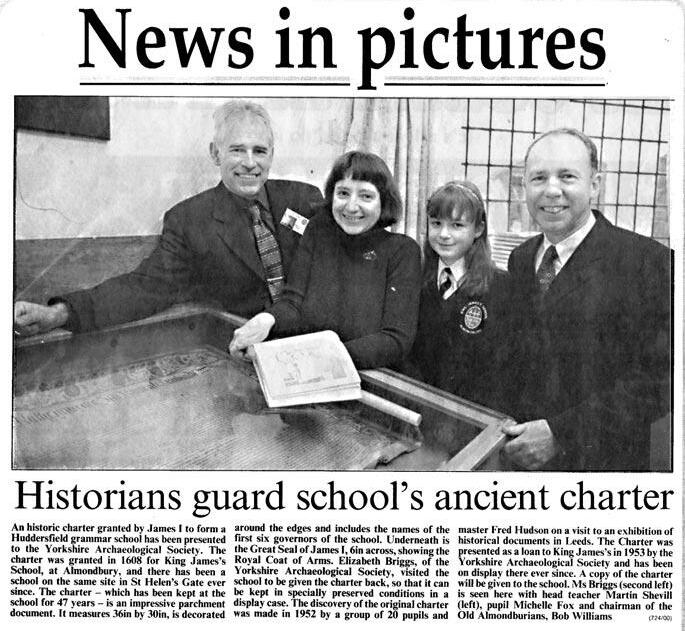
mental conditions and security.
The King James’s School archive is now in WYAS safe keeping and has been added to their database system. Detailed sorting, repackaging and cataloguing will now take place but the size of the collection suggests this will take more than a year. During this period, access to any part of the collection can be arranged and an archivist will assist in tracking down particular documents. Prebooking of appointments is necessary to enable the relevant documents to be located and copied when requested. The original copies are for reference only and cannot be removed from storage. WYAS will manage any data protection requirements for access to documents and also control exclusion of food, drink and writing materials. Photographing of documents is permitted for private research purposes but images must not be published or uploaded to the internet without permission. The archive will not be digitised, that would be a
hugely expensive operation, unless lottery or private donor funds could be accessed.
Another part of our archive resource, the back copies of The Almondburian , are kept on the shelves in the Local Studies library and are available for reference during normal opening hours.
Robert Clegg is our contact at the WYAS. He graduated in History and then took a masters course in Archival Administration. Appointments to access our archive and Royal Charter can be made via Robert at: Kirklees Archives, tel. 0113 535 0150 or by email

kirklees@wyjs.org.uk. n

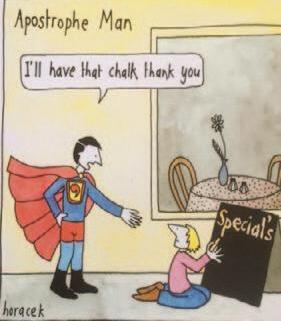

l take it you already know Of tough and bough, and cough and dough? Others may stumble, but not you On hiccough, thorough, slough, and through. Well done! And now you wish, perhaps To learn of less familiar traps?
Beware of heard, a dreadful word That looks like beard and sounds like bird And dead: it’s said like bed, not bead; For goodness’ sake, don’t call it deed! Watch out for meat and great and threat, (they rhyme with suite and straight and debt).
A moth is not a moth in mother Nor both in bother, broth in brother. And here is not a match for there. And dear and fear for bear and pear. And then there’ s dose and rose and lose Just lock them up — and goose and choose.
And cork and work, and card and ward, And font and front, and word and sword. And to and go, then thwart and cart. Come, come, I’ve hardly made a start.
A dreadful language? Why, man alive, l'd learned to talk it when l was five, And yet to write it, the more I tried, l hadn’t leamed it at fifty-five!
* Origin: unknown
Spotters: John Bradley, David Bush, the Editor
Have you spotted anything in print or on social media that has amused you or given you food for thought? If it’s worth sharing, send it to us at spotters@oas.org.uk.


Les continues his recollection of his career in General Practice and his rediscovery of his talent for art, in conversation with former classmate RICHARD TEALE.
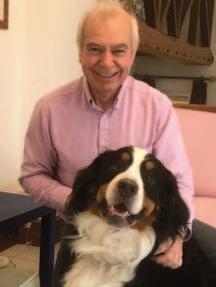
Iconcluded Part 1 of my story with my appointment in 1978 as a GP at the excellent General Practice at Shepley. I started working with two other GPs, a district nurse, a visiting community midwife and health visitor. During my 36 years in practice, I helped provide general medical services to three generations of the residents of Shepley and surrounding villages. Being entrusted with the care of children of parents whom themselves I had palpated when they were in utero and immunised as infants was a rare privilege and uniquely rewarding.
In the course of those 36 years I witnessed remarkable developments and advances not only in the delivery of care but also in the therapeutic options available to patients; from examining a patient by the light of a hurricane lamp in a remote farmhouse attic one snowy winter’s night, to referring a patient for treatment by a ‘cyberknife’, a machine in appearance not unlike a car production-line robot, that is capable of delivering extraordinarily precisely targeted radiotherapy in 4D, to lesions as small as 5mm in a patient’s lung,
synchronised to the patient’s breathing to minimise collateral damage to the surrounding tissue.
By the time of my retirement from fulltime practice in 2014, we had assembled a superb team of hand-picked individuals each of whom excelled in their area of expertise, be it clinical or administrative, practising in new purpose-built premises offering a much-appreciated service to our patients. Living within that community, in which our three sons grew up and were schooled, and in which we have forged strong friendships has further enriched the experience. I have been very fortunate.
Semi-rural General Practice in the 1970s and ’80s was not unlike the experience described by the vet James Herriot, but with generally more discerning and articulate patients. As we were located some distance from the nearest hospital A&E department, suturing of wounds and injuries, incision and drainage of abscesses, minor surgery and assessment of other trauma were all very much part of the job.
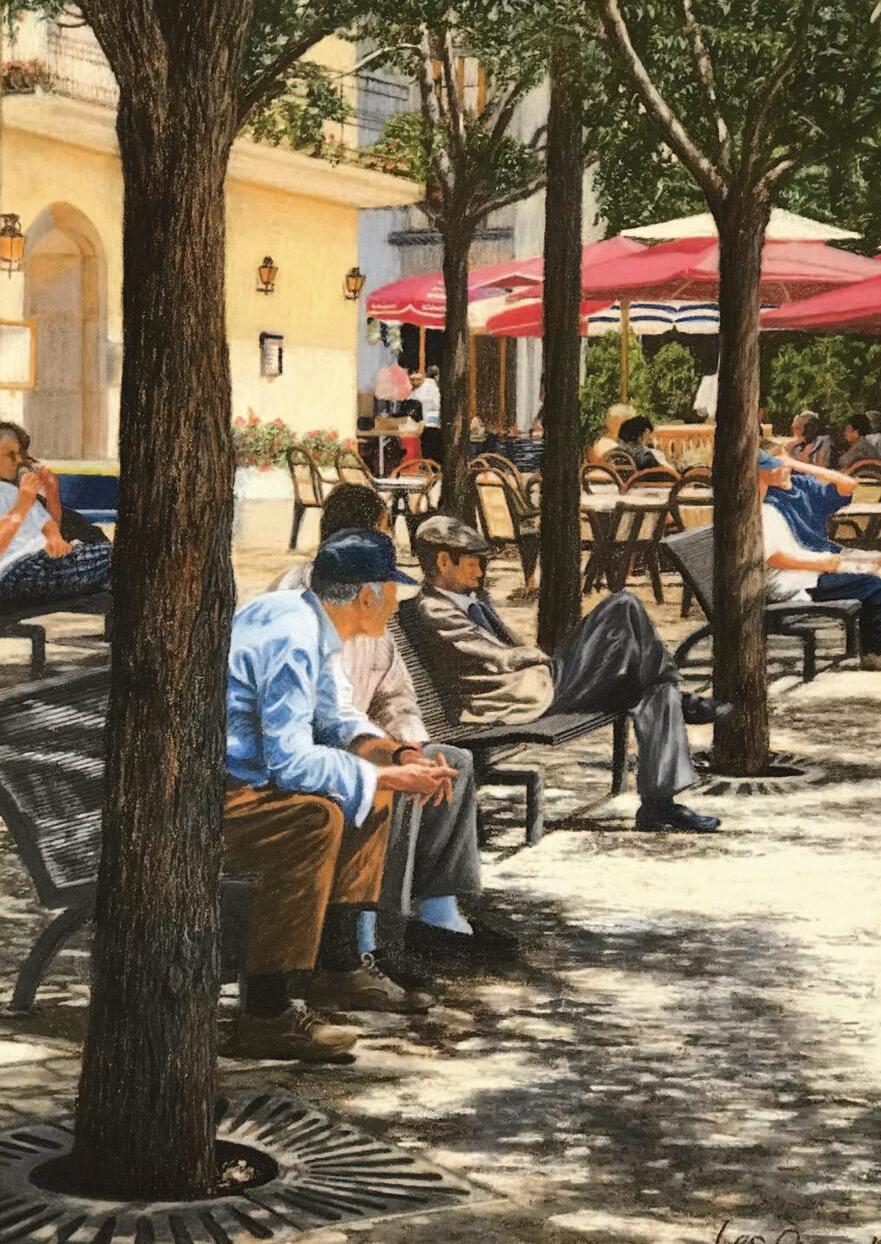
In those early years I had very little free time; out of hours cover at nights and weekends was expected of us and also very much part of the job, although after those punishing hospital rotas, one in three was comparative luxury! Arduous though the out of hours responsibilities were, being on-call provided some of the most professionally rewarding and memorable patient encounters.
It was normal clinical practice in those days to keep patients out of hospital wherever possible, and many acute medical conditions were managed at home; spending time in the small hours, drinking cups of tea and chatting with relatives whilst waiting for the patient to respond to treatment, cemented deep and long-lasting bonds in the doctor-patient relationship.
Being on call meant staying at home to answer the phone (no mobiles then), not only for me, but also for Kate, who needed to be on hand should I be out on a call; we had a young family of three boys, and a couple of Bernese Mountain Dogs.
Spare time was at a premium, but as the children grew up and found their own distractions their demands on our time diminished.
In 1990 Kate presented me with a box of pastel pencils for my 40th birthday, suggesting that during the evenings and weekends on call I might like to give them a try. It was to be another four years before I ran out of excuses, found the time and plucked up the courage to experiment with them. Mindful of the on-call background, the advantage of pastels over watercolour or oils was that there was minimal setting up time and I could leave the work at a moment’s notice, and return to it and pick up where I left off.
I had become an enthusiastic, albeit not terribly proficient photographer, compiling an increasing catalogue of holiday snapshots, so my first effort was to copy a not very original scene in Venice. In my ignorance I used cartridge paper which has minimal texture, or ‘tooth’ to hold the pastel, but with beginner’s luck I managed to get away with it, probably because pastel pencils – unlike the traditional chalks – are relatively hard and dense, and do not leave a large amount of deposit on the surface. Pleased with the outcome, and keen to experiment further I did acquire some Rembrandt pastel chalks and learned that Rembrandt paper, which is like very fine sandpaper, has such a texture so could hold and retain more pigment. All pastels release
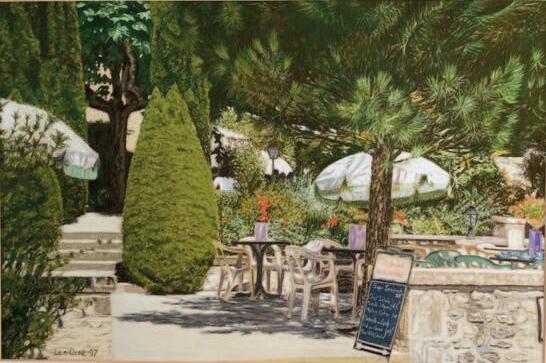
a fine dust and I was advised to use a fixative spray to prevent smudging and loss of pigment. One particular variety can be used repeatedly as the picture develops, as it not only fixes but leaves a toothed surface – a key – permitting overworking.
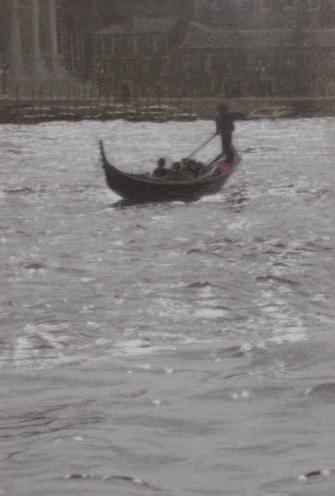
After the Venice experiment I did a few urban landscapes based on holiday photographs in the Dordogne and Provence. I like depicting the strong light and shade effects of more southerly latitudes, and have instinctively adopted a somewhat unconventional approach to using the pastel medium. Obsessional by nature, I like to try to re-create as much detail as possible; the pastel pencils can be sharpened to a fine point but also used for broader strokes if required. For laying on larger areas and particularly for achieving intense pale tones, the chalks are better, and can also be sharpened to a point if required. I tend not to use the usual “broad brush” technique, although I am a great admirer of those who can and

do use it with great success.There is a spectrum of softness with the various pastel chalks available, generally the denser the pigment, the softer and more expensive the pastel, some so soft and dense that drawing it across the palm of one’s hand leaves a deposit akin to lipstick, whereas the harder pastel pencils barely leave a mark.
I moved on from people being incidental in my pictures to the occasional full portrait. Shibden Hall near Halifax houses a craft museum where volunteer craftspeople occasionally resurrect traditional skills wearing period costume.The picture of the basket weaver is based on one such volunteer. I enjoy the process of building up layers within a work and there is a certain point when it comes to life as a three-dimensional character, which is always fascinating and intensely satisfying. I have a particular fascination with hands, perhaps because to the physician within me they have always been a source of interest and
information. I enjoy depicting them in as much detail as I can muster, and must confess that the obsessional within me finds it frustrating when visiting galleries, that some other artists do not share that enthusiasm!
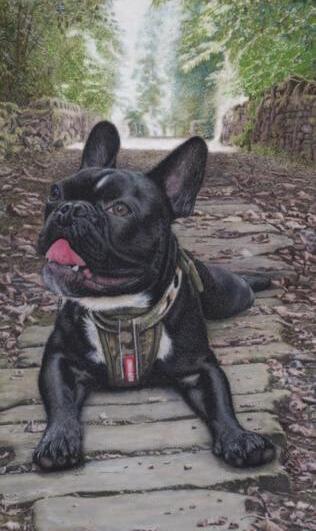
After that brief flurry of painting activity between 1994 and 1997, work took over once again and paradoxically, in spite of the cessation of regular out of hours work from 1999, the day job got busier, the working days longer and the pastels remained untouched for 20 years until retirement afforded me the opportunity and time to resurrect them from their boxes. As a housewarming gift to a former work colleague I experimented with juxtaposing the images from two photographs, imposing that of a much-loved French Bulldog against a woodland path background. I confess I revelled in trying to re-create the details in the curling leaves and twigs and in doing so derived just as much pleasure as that gained from the dog’s features and harness. Joey (the Frenchie) was well received and triggered a succession of similar canine adventures for ex-colleagues, latterly Olive, a whippet whose second home is Canon Hall, hence the depiction of the folly there in the background.
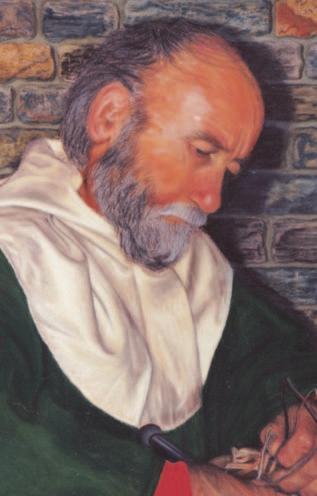
I am fortunate in having an outbuilding in the back garden which I use as a studio, originally built for Kate to use for her sculpture. (She underwent a career change on turning 50, switching from nursing to sculpture and fine art. She now has a large studio at the Yorkshire Art Space in Sheffield).
That old chestnut about retirement and wondering how one ever had time to work has certainly been applicable for the last twelve months; in spite of Covid lockdowns, my time has been consumed with a substantial house extension, so once again, artwork has gone onto the back burner. Nevertheless, I am looking forward to a resumption, and possibly a return to portraiture, who knows? That freedom of choice is one of the joys of retirement, to which I feel I have at last adapted, although it has taken longer than I expected.
After formally retiring from full-time practice in 2014, I continued to provide sickness and holiday cover at Shepley for a further three years, during which time I also
volunteered my services to the Advanced Care Practitioner course run at Huddersfield University, teaching consultation and examination skills and passing on what advice I could to the students. I have long held the view that in the era of re-cycling, we fail to preserve one of our most precious assets, the skills, acquired wisdom and experience of our workforce, and simply let it drift off into retirement. I believe everyone, regardless of their occupation, should take on an apprentice for the last year of work and pass on as much of that knowledge as possible. Quite apart from the inherent value of the process to the recipient, (and the national workforce) the
retiring individual is afforded the opportunity to reflect on just how much experience and knowledge he or she has acquired, and can enter retirement with head held high, and a greater sense of achievement. I have tried to uphold this philosophy in my own approach to retirement.
My decision to pursue a career in Medicine was serendipitous; it is one which I have never regretted. It would appear however that, after a career in the Sciences, although I would argue that there is an Art to the successful practice of Medicine, I have returned to my artistic inclinations in retirement, and am thoroughly enjoying it.
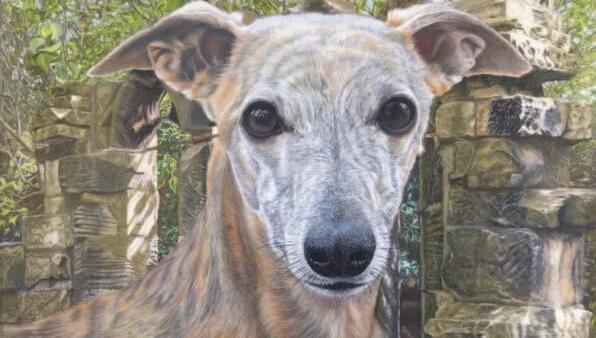
lRichard Teale, Les Orme and others are arranging a ‘class of 1961’ reunion at the OAS dinner on 20th November.
Difficulty: tough
Each row, column and 3 x 3 box must contain the digits 1 to 9
IN our November 2015 issue we published a number of previously unseen paintings by former Art master Edward ‘Teak’ Akroyd.
A further painting has now been kindly sent in to us by Hilary Pollard, whose late husband Brian (inset) attended King James’s Grammar School from 1946-1951.A view that no longer exists, it shows the area behind the oldest part of the School. In the distance on the right is the ODH, with Dorm 4 above.
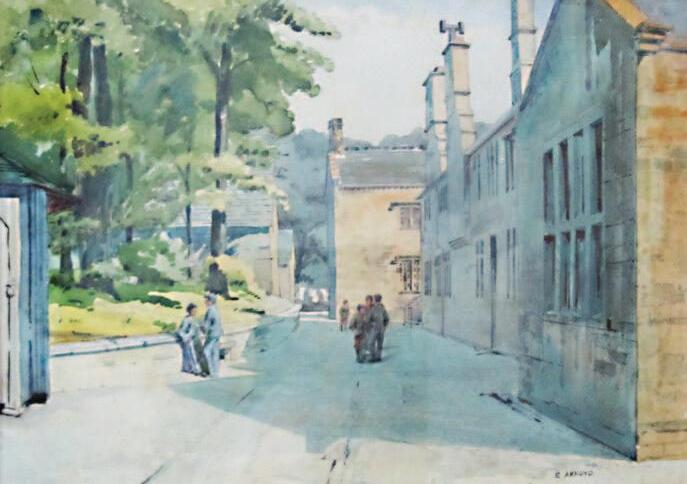
The buildings on the left include the former classroom and chemistry laboratory known as ‘The Cloisters’. It later became an outside cloakroom and was finally demolished in 1938. The painting was therefore probably painted in the early 1930s.
The painting has an interesting history. It was originally presented to John Baldwin, headmaster from 1945-48 on the occasion of
his retirement and in due course came into the possession of his son Kenneth.The Baldwins were former neighbours of the Pollards and when Kenneth left the family home he kindly gave the painting to Brian Pollard, whom he knew to have attended KJGS during John Baldwin’s time as headmaster.
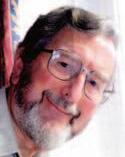
It may be noted that the same view formed the basis of an almost identical linocut by Edward Akroyd (below) which we published for the first time in our November 2012 issue.
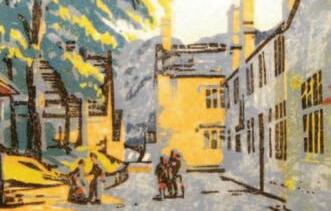
Reporter/participant:
Another keenly fought contest at the Woolpack as the popular annual Quiz Night at the Woolpack returns after the 2020 Covid-19 lockdown.
It is well over two years since our last gathering of teams competed to answer the challenging questions posed by Keith Crawshaw. Would enough regulars and new faces come out after lockdown to ensure a successful evening? Of course they would.
Once again, we had five teams competing for the trophy and, after explaining the rules, Keith presided over ten rounds of sometimes straightforward, sometimes devious subjects. This year being the delayed celebration of our centenary, many of the rounds had a 1920 or 2020 theme.
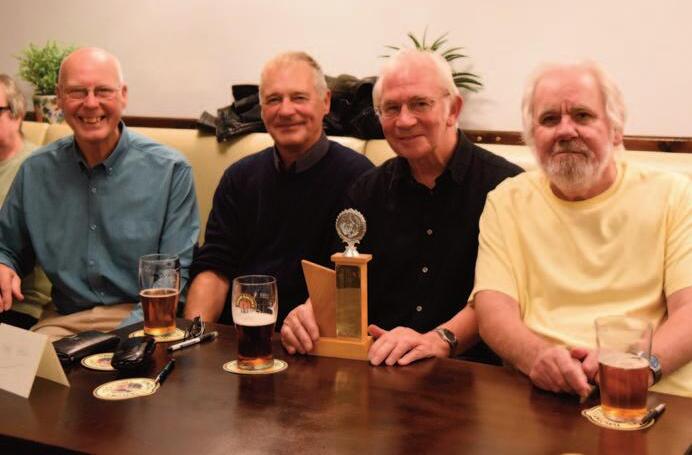
We opened with a selection of correct answers from multiple choice possibilities of What happened in 1920 and Who was alive in 1920, which most teams struggled with. The next two rounds, Novel quotations and Olympic games allowed more respectable scores.
Then followed the first Buzzer round; though we didn’t have buzzers the principle of losing points if you answered incorrectly was applied. In Yorkshire words the selection of definitions for dialect terms caused much repetition of ‘I’ve lived in Yorkshire all my life and never heard that!’ The last round before the break, Faces , restored some
normality, identifying celebrities from photos.
After topping up our drinks, we continued with In which decade?, 20 events that had to be given their correct time slot. Then another Buzzer round led to more points deductions. The final two rounds, Wild flowers (identifying from photos) and Yorkshire in 2020, allowed most teams to gather points and post respectable final scores.
Congratulations to The 60s team on finishing clear winners on 174 points, though First and Last and Badminton were both within 10 points of them. Walter Raleigh presented the trophy to the winning team and gave thanks to all for attending and to Keith, our very own Jeremy Paxman, for well composed questions and adjudication
on disputed answers. Special thanks are also due to Charlotte Haigh (King James’s School student and Andrew’s daughter) for her careful and efficient scoring. A very enjoyable evening was had by all and we hope to reconvene in 2022 for more of the same.
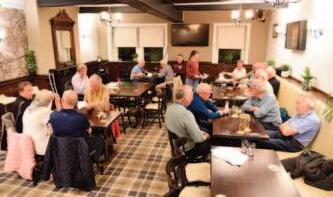

Things often look different when viewed from afar.We invite our man in the US to give us his personal perspective on some of the issues and questions of the day
QIt’s just 20 years since the 11/9 atrocity.You were working not far away: what are your memories?

Charlie’s view In the summer of 1980, I was excited to take my first trip to NewYork City. One of the first landmarks I visited was the imposing World Trade Centre, located in the business district at the southern tip of Manhattan Island.While my preference would have been to follow Kong in visiting midtown’s Empire State Building, my American hosts insisted this was going to be even more impressive.
Previously, the highest building I'd been up was Blackpool Tower.This would be a slightly different experience. After we purchased visitor passes at theWTC's South Tower lobby, an express elevator catapulted us 107 flights to the 'Top of the World' indoor observation deck. If I remember correctly, it took no small amount of coaching to pry me away from the back wall to the escalators which carried visitors to the open-air top deck on the 110th floor. Once there, we enjoyed a magnificent, unobstructed, vertiginous view of the city, which included the aforementioned Empire State. It was a memorably hot, sunny day and even though a smoggy haze hung over Gotham we could see for miles around.
On the morning of September 11th, 2001, I was at home leisurely brewing a cup of tea and getting ready for work. My daily shift at New Jersey Network Television didn't officially begin until 10 a.m. and at that moment I was blissfully unaware of the earth-shattering events already taking place a mere fifty miles away. Short ly after 9 am the phone rang unexpectedly. The caller was my sisterin-law, telling me to switch on the television right away: both World Trade Centre towers had been hit by aircraft and were engulfed in flames. I immedi ately put down my cup and dashed out of the house. In scan ning the news stations on the car radio, what was happening wasn't exactly clear, but the cause ap peared unlikely to be an accident.
I arrived at NJN studios half an hour later to find the rest of the graphics staff gathered in front of the TV set in our department head’s office, watching openmouthed as the tragedy unfolded in real time. Then, to our astonishment, the WTC South tower suddenly crumbled into a huge plume of toxic dust.

In fairly quick succession reports came in of a third hijacked plane, this one hitting the Pentagon in Virginia, followed by a fourth that had crashed in a field in Pennsylvania; we later learned an intrepid group of passengers prevented the hijackers of United Airlines Flight 93 from reaching their intended target of Washington's Capitol Building.
At 10:28 a.m. the North Tower fell.
It was feared this might only be the opening salvo of a larger coordinated terrorist attack on America. It wasn’t, but the damage was done.
The WTC consisted of seven large buildings but, since size matters, the two tallest naturally grabbed all the attention.
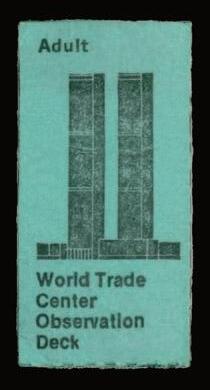
The Twin Towers weren’t quite identical twins: the North Tower was measurably taller because of its massive rooftop antenna, utilised by multiple New York television and radio stations. As fate would have it, only 24 hours before, an NJN camera crew and producer had been filming there. Meanwhile, across the border in New Jersey, in addition to its four main transmitter facilities located around our state, NJN also had a ‘satellite’ transmitter atop the Empire State Building. This enabled us to take the feeds from NewYork's Channel 7 and WABC after the North Tower collapsed. Breaking with its regular format, NJN remained on the air broadcasting continuous live coverage for the next several days.
The consequences of the attack were felt locally in often heart-breaking, personal ways. For weeks after the disaster, dozens of commuters' vehicles remained unclaimed at bus and train station parking lots along the Northeast Corridor between New Jersey's capital, Trenton, and New York. 750 of the more than 2,700 fatalities at the WTC site were NJ residents.
In light of later events, it’s easy to forget that Rudolph Giuliani, Donald Trump’s personal attorney and increasingly unhinged vocal advocate, was the Mayor of
New York City at the time. In spite of mounting public dissatisfaction with his job performance, the veneer of leadership that Giuliani projected in the immediate aftermath of the attacks impressed the national media who dubbed him ‘America’s Mayor’. All the attention reportedly emboldened his pre-existing narcissism, even fueling an unsuccessful run for the presidency, and prepared the way for his next big career move.
In response to 9/11, President George Bush Junior launched what became the nation's longest overseas conflict, a multibillion-dollar War on Terror which claimed tens of thousands of lives in Afghanistan and Iraq. At home, anyone who marginally looked like a Muslim was now viewed with suspicion and likely to suffer discrimination or abuse. Al-Qaeda and ISIS became bywords for terror. Airports ramped up strict security measures that out of necessity stripped the pleasure out of flying. State surveillance of individuals expanded exponentially. Exploiting the internet, conspiracy theorists continued to spread fear and deploy fake news to a newly receptive and cynical audience; some even claimed the eventual capture and death of Osama bin Laden, mastermind behind 9/11 and earlier attacks on American interests, was a hoax.
It's become a cliché to say that the ripple effects of September 11th changed America forever. But it’s true.
QYou’ve spent most of your career in American television. How does it compare with British TV?

Charlie’s view When I relocated to the US in 1981, one of the first luxury consumer items I indulged in was a new Quasar brand 19-inch colo(u)r telly, necessitated by there being no available equivalent to the UK’s Radio Rentals. Initially struck by how different this country's broadcast system was from the British model I’d grown up with, in no time at all I adjusted to the all-day schedules of multiple channels on UHF andVHF wavelengths, soon to be joined by that new kid on the block: cable TV.
Once Upon a Time, in America when dinosaurs roamed the earth, there were three major television networks: NBC, ABC, and CBS, plus local affiliate stations. They were all free to watch – minus the cost of an analogue set – because they owed their existence to advertising dollars derived from product commercials. Beginning in the 1940s, the networks were motivated by profit, yet they strove to provide content serving the tastes of everyone from smartypants to imbeciles. During the so-called ‘Golden Age’ of the 1950s, programmes ran the gamut from the dramatic presentations of Playhouse 90, U.S. Steel Hour, and Kraft Television Theatre (not as cheesy as you might think), to daytime ‘soap operas’ (afternoon serials spon-
sored by soap companies), daft sitcoms, inane game shows, and bland variety entertainment such as The Ed Sullivan Show. Incidentally, Ed is best remembered by America’s 1960s generation for introducing the Beatles to the masses.
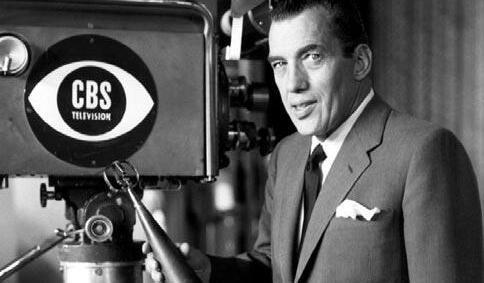
These stations were later joined by the non-commercial Public Broadcasting Service, sort of analogous to Britain’s BBC but paid for by government grants and public donations. From its inception, public broadcasting was associated with imported ‘highbrow’ British programmes. It’s that ‘accent’ thing, don’t you know.Thankfully PBS didn’t air On the Buses or George and Mildred, which might have tainted our brand a little. Conversely, it was often cheaper for Britain to purchase pre-made American shows rather than produce its own; my childhood would definitely have been poorer without exposure to My Favourite Martian, Mr. Ed, and The Man from U.N.C.L.E.
In the US, Public Television remains highly respected among the ‘educated elite’ but others now regard it as redundant because many high-quality documentary and educational programmes can be viewed on various pay channels.Thanks, capitalism. It’s not widely understood over here that the BBC is funded via a compulsory licence fee, something that would be deemed a communist plot in The Land of the Free.
However, in common with Genera-
tions X,Y and Z, I rarely watch traditional network TV anymore. Every few minutes a flurry of commercials rudely – and loudly – interrupts the programme’s narrative flow, and anyway those cheap-to-make ‘reality’ shows and dance competitions just aren’t my cuppa tea. In recent decades broadcast networks have lost many viewers to cable, satellite, and streaming services. Providers such as Netflix, Hulu, Amazon Prime, and Disney+ allow subscribers to indulge in the armchair sport of binge-watching when entire seasons of new shows are made instantly available. Really, what else is there to do while corralled indoors in fear of being stricken by Covid-19?
Incidentally, in terms of media control, DisneyCorporateWorldDomination, Inc. owns the Marvel catalogue, Pixar, The Muppets, Twentieth Century Fox, The Simpsons, Lucasfilm and the Star Wars franchises, while TimeWarner’s assets include DC Comics, HBO,Turner TCM, and I think Jeff Besos and Elon Musk own everything else on the planet. Including you.
Curiously, the pandemic succeeded in generating an unanticipated surge of interest in both national and local evening news programmes while the public was being
bombarded with daily death tolls and confusing, often contradictory safety recommendations. To mask or not to mask, to vaccinate or not to vaccinate, those were the questions. (I hope my former King James’s biology teacher Jack Taylor would be pleased that I took my cues from the 1970s Nuffield syllabuses and deferred to science-based logic when it came to getting jabbed.)
As a former television news worker bee, I’m disturbed by how dangerously politicised the presentation of information – and misinformation – has become. Sadly, viewers can now tune in to channels and internet sources that promote their own personal beliefs to the exclusion of contradictory points of view. From Ted Turner’s CNN and Comcast’s MSNBC on the Left to Rupert Murdoch’s Fox Channel and the Herring Networks’ OAN (One America News) on the Right, pandering to polarised audiences has done much to fuel the fragmentation of modern American society.
Once Upon Another Time there was an
exceptional American TV news anchor named Walter Cronkite whose calm demeanour and apolitical honesty established him as a trusted, national treasure. He hand-held millions of viewers through the Kennedy and King assassinations, the Apollo Moon landings, and the trauma of the Vietnam War.The kind of in-depth reporting he represented that explains the details and context of news stories has been replaced by fastpaced, twenty-second soundbites and attention-grabbing smartphone snippets. Call me old-fashioned, but in 2021 I would welcome watching a reporter of Cronkite’s presence on my 55-inch flat screen Samsung TV. I miss the dinosaur era.

QCovid-19 continues to make its presence felt. How are you and yours coping?
Charlie’s view A mere two years ago who among us could have accurately predicted how radically our lives were about to change? No, I’m not referring to last spring's Marmite shortage. If you’ve drawn back the curtains to anxiously peer through your window of late you may have noticed that our world is (as I write) enduring yet another wave of viral pandemonium, being
plagued by cyber-attacks, unsettled by fears of a newly resurgent Taliban in Afghanistan, and ravaged by unusually severe weather events – droughts, flooding, forest fires, hurricanes, and earthquakes.
On top of all that, in January I had the misfortune to lose my best pal. Podgy the cat was around 16 years old, and he eventually fell victim to an illness that several vets were unable to successfully treat. In his final weeks he displayed more affection than was usual even for him, curling up in my arms every night before he fell asleep, as if he knew I needed this as much as he did. He was one of those ‘special’ pets, so much more than just a furry presence asking to be fed at the most inconvenient hours. He was, in a word, catnificent, and he’s sorely missed.
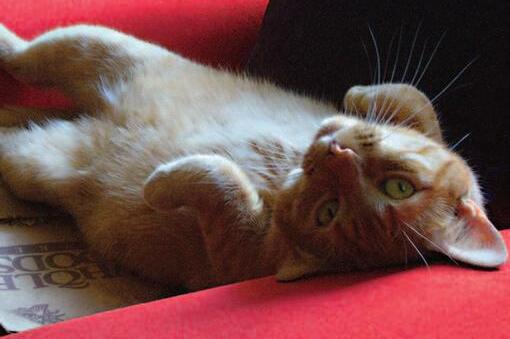
I’ve said farewell to cats before, yet the inevitable grieving was magnified this time by what was going on around us all in Pandemic World, a scary theme park that nobody wanted to visit, ever. The social and economic fallout from the global contagion have taken a toll on almost everyone's mental health. According to the most recent World Happiness report (yes, there is such a thing), 22% of those surveyed in the UK have reported feeling more anxious and depressed. Not surprisingly, companion animals have played their part in
alleviating anxieties borne of isolation, concerns over being furloughed or fired, fears of infection and the lasting effects of ‘long Covid’, and of course the loss of friends and loved ones.
Pet adoption numbers spiked as many struggled with imposed confinement during the successive, oppressive lockdowns of the last eighteen months. During that time the UK's Pet Food Manufacturers’ Association estimated 3.2 million households acquired a cat or dog, while here on the non-British side of the ocean an American ASPCA survey pegged the number of new four-legged friends at 23 million. As workplaces were forced to close their doors, those who were able made the transition to working from home, but some found that environment wanting. All at once a lot of people chose to become first-time pet owners or foster parents, often with little or no prior experience and, sometimes, unrealistic expectations.
In the US, that bastion of supply-anddemand economics, an unfortunate consequence of the unprecedented surge in demand has been a rise in pet prices, inad-
vertently enhancing the fortunes of unscrupulous ‘puppy farm’ operators.There's even been an increase in thefts involving the most-popular pedigrees.
Personally, I can’t understand why someone would purchase an expensive designer pet from a breeder when charities are doing all they can to rehome as many needy animals as possible and, at the same time, reducing the scourge of overpopulation through spayneuter-return programmes. According to the UK’s 2021 PDSA Animal Wellbeing (PAW) Report, 31% of dogs are bought from breeders whereas most cats are rescues. Rover, the world's largest network of pet sitters and dog walkers, states that 40% of owners adopted from a rescue or nonprofit organisation. Unfortunately, animal charities and shelters have struggled because of the financial impact of the pandemic on donations and a reduction in the number of volunteers. However, one positive outcome has been an increase in older animals finding homes, not just the usual cute puppies and kittens.
The unconditional, non-judgmental, empathetic nature of a pet’s love is surely apparent without the need of scientific proof. Nevertheless, research has proven that oxytocin, cortisol, dopamine, and blood pressure levels in humans are positively enhanced by pet interaction. It’s been well-documented that animals help former soldiers deal with PTSD, aid in regulating mood swings in children diagnosed with autism and other emotional disorders, offer
reassurance to seniors who often experience loneliness, and provide companionship for the homeless. Visits by therapy animals to nursing homes are especially appreciated by residents, especially those suffering from dementia.
It does require a serious, long-term commitment to care for a domesticated animal. Puppies require training, as do adult dogs with behavioural issues. In addition to the benefits, it must be said that pet ownership can also be the cause of some stress: just try administering a pill against your cat’s wishes. Concerns may include: can I afford the food and vet bills? What happens if I need to move to a place where they don't allow animals? Why is my dog chewing the furniture, and why has the bloody cat started to tinkle outside its litter box? (Take it from me, an errant feline turd is much easier to clean up than pee.) And who truly enjoys the chore of bending down to scoop their dog’s Mars Bars from the footpath on a cold, blustery winter’s day?
There is a real concern that, post-pandemic (whenever that happens), people will readjust to their previous routines, and perhaps feel like they can’t spend as much time caring for their pets. The Dogs Trust charity, for one, seems to indicate this is already beginning.The last thing these animals need is to be dumped at shelters... or worse. My hope is that these trying times are teaching owners the true value of pet companionship... and how to keep the cat from walking on the damn computer keyboard. n
The unconditional, nature of a pet’s love is apparent without the need of scientific proof.
Roger Sykes (1946-1953) revisits some of his favourite drawings
BEING born and brought up at Stirley Hill, just below Castle Hill, means that any glance in that direction on the way home from school down in Berry Brow was a relief! Half way home indeed. And an auntie, Clara Sykes, lived in a cottage at Lower Park. Another lived lower down in Hangingstone Rd. I remember searching for incendiary bombs in the garden and nearby allotments during the war – and finding one that had bounced off the roof tiles.
Two large bombs were dropped behind the houses on Stirley Hill and blew out all the windows whilst we were sheltering in the cellar during a raid on Huddersfield.
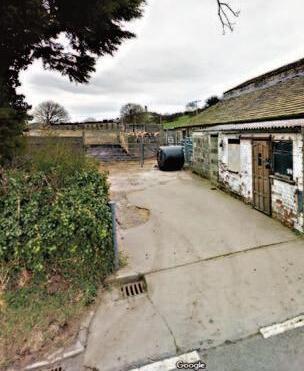
Berry Brow school was my first introduction to drawing and painting. Miss Turner, our art teacher, entered me for a Huddersfield safety poster competition. I won many books for the school with a picture of the road to Castle Hill, with the subtitle “If for pleasure you drive in a car, don’t let your eyes from the road wander far”.
So finding a view through the farmyard was a natural focus on the tower, the size of which I exaggerated a little so that it was more visible within the small In and About newspaper column width when it appeared in the Huddersfield Examiner.
Castle Hill district was within the catchment area for King James’s with a direct bus route to Almondbury. No more walking to school!
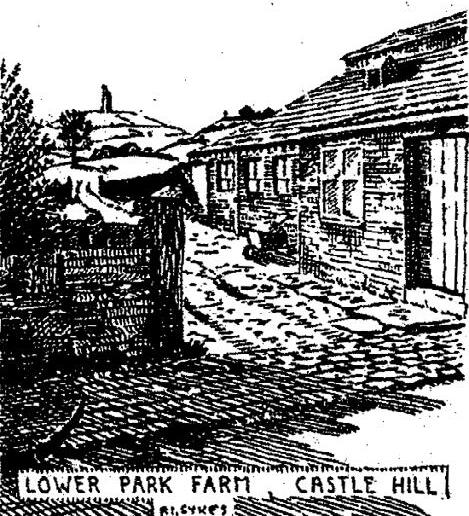

SINCE we were not allowed to play badminton in the first half of 2021 due to Covid-19 restrictions, we started to play tennis early, indeed, as soon as we were allowed to, on Thursday, 1st April. Once again this year we enjoyed the facilities of Longley Tennis Club and, generally, some very fine weather, although there was one week early in the year that we found ourselves playing tennis in a hailstorm – but it’s all character-building, isn’t it?. We were able to play most Thursdays from 1st April until 2nd September, with the exception of a fiveweek period in late July and early August when there was only one person not on holiday in any given week. There were a couple of other weeks when we found ourselves down to just two players and having to play singles. One of these was particularly memorable because the Longley team mem -
bers were training on the next court. When they had finished they were looking down to our court just as David Parry and Andrew Haigh rather fortuitously embarked on a particularly impressive and most unusual long rally. One of the Longley Team declared “I don’t know how you got to some of those shots then!”, to which David Parry replied “What do you mean? There’s a finely-honed athlete inside here.” (as he patted his stomach). The quick response from the Longley team member provoked much hilarity: “It’s in there, it’s just very well-concealed!”, he said.
The stalwarts of the Tennis Section are Robin Merchant, David Parry, Andrew Haigh and Neil Gledhill, although we were joined on one occasion by Eleanor Haigh and Matthew Booth, who turned up without a racquet claiming to be unable to play tennis, borrowed the Longley Coach’s racquet and proceeded to win!
Once hospitality had opened-up again in the summer we were able to retire to the Golden Cock at Farnley Tyas to enjoy a post-tennis beer in their outdoor seating area. n Three stalwarts of the Tennis section Andrew Haigh, Neil Gledhill and David Parry under the floodlights at Longley on the last playing evening of the season.

THE new badminton season started unusually late this year, on Thursday, 9th September. It also got off to an extremely quiet start, since many of our regulars were still away on holiday and only three people turned up to play: Ian Daffern, David Parry and Andrew Haigh. There was a slight improvement the following week, when those three were joined by two Year 10 pupils: Eleanor Haigh and Charlotte Haigh. There was no badminton in the third week of term, due to the Open Evening at School, so we reverted to tennis instead. Hopefully, next week will see a few more badminton players on court. We play in the KJS sports hall each
Thursday evening during term-time, from 7.30 pm until 9.30 pm, until Thursday, 26th May 2022. The fee, to cover the hire of the sports hall, shuttlecocks and showers, is £5.00 per person per evening. Afterwards, we adjourn to the Conservative Club for refreshments. Why not come and join us? n
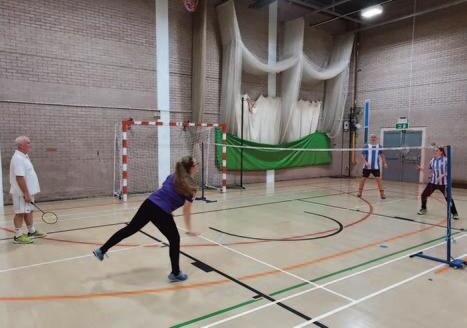
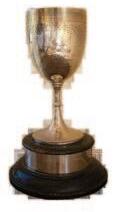
ROBIN MERCHANT robin.merchant@oas.org.uk
l WINNER
Simon Russell (37 points)
l 2nd place
SIMON RUSSELL was again the triumphant winner of this year’s Gothard Cup competition, held at its traditional home of Woodsome Golf Club on Sunday, 13th June.
Nine Old Almondburians took part: Robin Sharman, Paul

Richard Brown (35 points)
l Longest Drive
Simon Russell at the 14th
l Nearest the pin
Grant, David Parry, Simon Russell, Richard Brown, Jon Roberts, Tim Roberts, Geoff Headey and myself. We were joined for the second time by Michael Blakey, whom we now regard as an honorary Old Almondburian.
Richard Brown at the 10th
We were blessed with
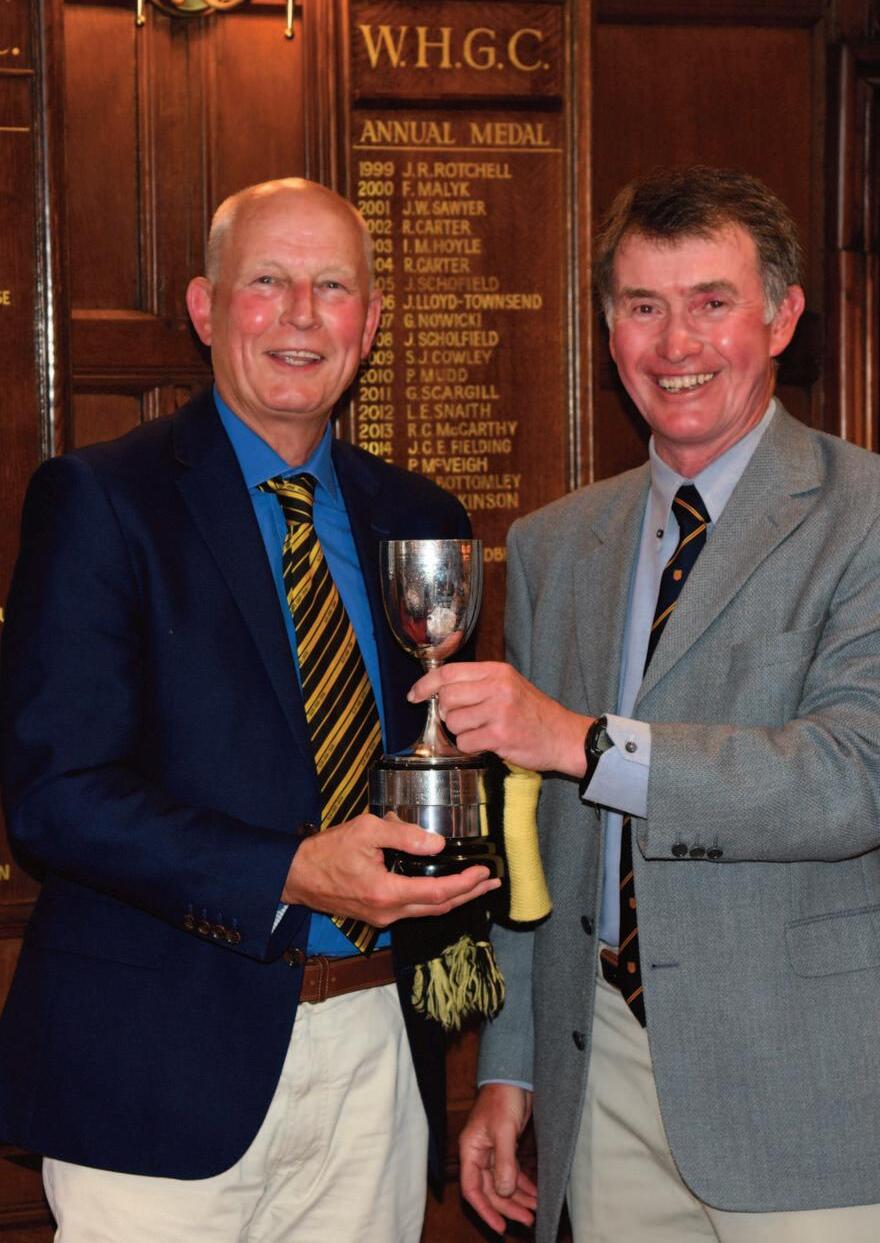
good weather and found Woodsome to be in fine fettle, particularly with the new and improved stream and pond in front of the 9th green.
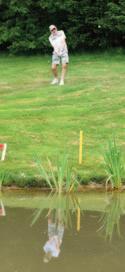
Our congratulations to Simon – I did mention last year that his handicap should be reviewed but as with most things I forgot. But don’t worry Simon: I will not forget next year!
It was good to have Richard Brown taking 2nd place – he has been unable to join us for too long.
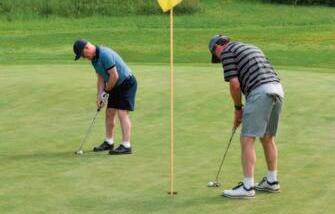
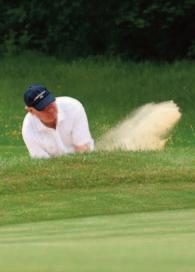
The other prizes were also hoovered up by the dynamic duo, but not everything went their way as Richard is on a yellow card for not coming properly attired, as he was not wearing an OAS tie!
Following the golf, we enjoyed an excellent meal and many thanks must go to Woodsome for providing a great venue for our competition. Many thanks again to Robin Sharman, who made all the arrangements with the club.
After the meal, Richard, who must have been in a very good mood having played well and picked up two prizes, asked if we might enjoy a bottle of vintage port from his extensive cellar next year. I don’t know why he bothered to ask as the response was an overwhelming YES!
We again collected £30, for a School Prize which will be presented to the pupil ‘achieving the best sporting achievement outside the School’.
The Gothard Cup is planned to be contested in mid-June 2022 and if you think you might enjoy some good company mixed in with some golf and a glass of Richard’s vintage port do try and join us. n
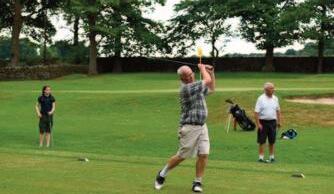
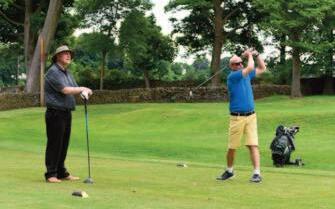
WE are Tim and Karin Robinson from Lincolnshire England. We lived in Kentucky for nine months and it was great seeing this photo in a Cracker Barrel restaurant in Morehead Kentucky, I knew this was not an American school!
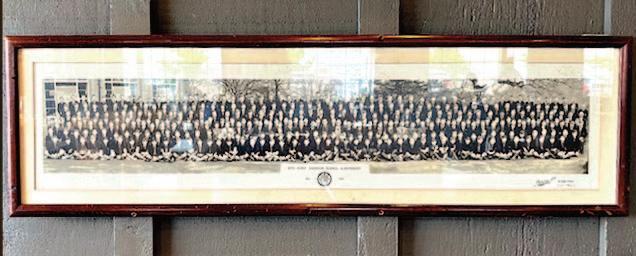
Lincolnshire
l We’d be interested to know if any reader at the School at this time who is aware of any pupil who emigrated to the USA and subsequently worked at a restaurant in Kentucky.
As it happens, I was present when this photo, typical of the period, was taken in 1955 by Panora Ltd. The company used a camera mounted on a tripod which rotated using a clockwork mechanism so that it took several seconds of complete stillness before the photo was completed. It was not unknown for a mischief-maker to run from one end to the other while the camera was in motion, thereby appearing at each end, though sadly no-one in this group showed such enterprise. Nowadays, such pictures are taken using a fixed camera and an anamorphic lens, and Panora Ltd went out of business in the 1980s.The entire stock of negatives is held at the Greater Manchester County Record Office. (Ed).
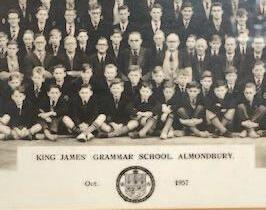
THANK you very much for yet another excellent edition of The Almondburian. Not only is it beautifully presented and produced, but the content, as ever, is most interesting and stimulating. It re-fertilizes my roots and reaffirms my foundations
I note that the Annual Dinner will be on Saturday 20th November, and that on that day also, Huddersfield Town will be at home to play West Bromwich Albion, a double reason for making the journey from Geordie Land.
I read that the Sunday Founders’ Day event has not been well attended in recent years and has also presented problems in terms of School participation. This year’s event will be held on Friday 19th November at 2.00pm.
Founders’ Day has been a traditional event for many years. I am sad that it has not been well attended in recent years.
I think that if I had had the choice in my School-boy time I too would probably not have attended. But I did not have the choice. There was, as I recall, a three-line whip on attendance and the full muster of students and staff preceding the ceremonial walk up St Helen’s Gate on a Sunday afternoon in November was a formative, memorable experience, just as was taking part in the full spectacle of Speech Day in the Town Hall in February.
To give thanks for the foundation of the School, to which we all belonged, and so clearly in person were part of by being there, was important. Founders’ Day told
us that the School, founded in 1608 and which has continued to flourish (‘Floreat Schola’) was special. Its staff and students were/are special. and were/are the successors of many who had passed that way before.That sense of belonging, and of heritage, was reinforced by attendance at such events as Founders’ Day and Speech Day.
Traditions can too easily be scoffed at. But they have an important part to play in the early lives of students, for they are the staging posts along a journey. If we know where we come from we might be more assured and confident in our onward paths.
I do not know whether, or how, the current students at KJS are made aware of their heritage. I would hope that they are proud of their School, and that their roots are well fertilized and their foundations made firm. I would hope that attendance at Founders’ Day would be a celebration of where they are and what they are.
In support of this aspiration I would suggest that the School be closed on that Friday afternoon, that the whole school, its staff and students, or as many as possible, assemble and proceed on up the hill to the glorious parish church in Almondbury, to celebrate the foundation of the School, and all that it stands for. Those able to fit into the Church will remember it, and learn from it. Those able to enjoy a half day off will give thanks for it. Win, win.
But then the cold reality of logistical planning rears its head.
Whitley Bay, NorthumberlandIwas saddened to read Tony Cape’s obituary for Martin Harrison in the centenary addition of The Almondburian . Like Martin and Tony I joined 1A in 1962. I was always impressed by Martin's academic ability, without any arrogance or conceit. He had humour, integrity and an empathy for others. I lived only a mile away from his home in Quarmby, and on occasional
days we would walk and talk together. He and Tony were the leading lights in the humanities subjects, whilst John Dale and I were rivals in the sciences. Martin was very approachable and a good friend, though our ways separated when we moved into Transitus. I am sorry that the world has lost him, and I give his family my best wishes.
Oakham, RutlandIwonder if many readers saw a recent programme on BBC 4 about the re- definition of the kilogram?*
In 2019 the Bureau of Weights and Measures (BIPM) in Paris re-defined the Kg in atomic terms. I watched with particular interest because in 1960 I had been at the BIPM Conference when the metre was re-defined. I was there as a member of the UK delegation (the first time I had attended an international meeting) because the Agenda included the item ‘Proposed Revision of the BIPM Constitution.’ BIPM had a C19th constitution in the form of Statutes under French public law, not a treaty as is usual these days.
A Legal Committee was charged with dealing with the question (it did not get far because of political problems such as who should represent China and Germany).
After the Plenary had adopted the decision to re-define the metre, we all adjourned to the vaults underneath the HQ
building where the metre and two ‘deputy’ metres were each kept under bell jars behind several locks. The President opened the doors and removed the master metre from under its bell jar and handed the then redundant rod of metal to the delegates to hold and admire. Champagne was drunk. Down the corridor there was a separate vault containing the Kg.
The experts at the time thought it was too difficult ever to re-define the Kg, so the lump of metal remained closely guarded. National metres and Kgs were brought to Paris at regular intervals to be compared with the first deputy. The latter was the only one to be compared with the master metre or Kg.
Chislehurst, Kent
l A more detailed account of this occasion will appear in the March 2022 issue of The Almondburian.
*Measuring Mass – The last artefact was broadcast on BBC 4 on 15th September 2021.
Specialist pressure vessel designer who loved sailing trips in the UK and abroad
We report with sadness the death of Malcolm ‘Swannie’ Arnold on 3rd September. He joined King James’s Grammar School in September 1948, leaving with ‘A’ levels in Maths, Physics and Chemistry to take a degree in Mechanical Engineering at Liverpool University.
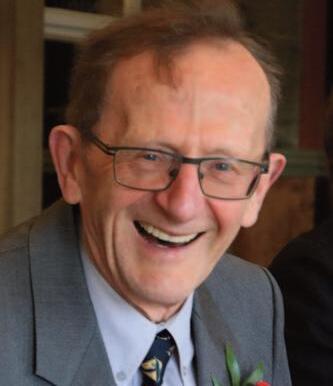
Malcolm’s first job was with W & T Avery in Birmingham, during which time he joined the Inter-Varsity Club (IVC). It was a sound move as this was where he met his wife-tobe Elizabeth at a Friday-evening dance.They married in 1964, and two children soon followed; a third arrived 15 years later.
Malcolm left Avery in 1962 to join the family firm William Arnold & Son which manufactured pressure vessels. He greatly enjoyed designing these vessels and associated mechanisms – one monster was 26 metres long and weighed many tonnes.
But he also loved his holidays, which tended to go in phases. For 10 years he went sailing off Abersoch, North Wales; this was followed by some 10 years of sailing tuition at a church-organised camp on the banks of Loch Lomond, attended by up to 300 children and 200 adults. Later he enjoyed sailing trips with family and friends in the Mediterranean and visits to Mombasa and Sri Lanka.S
Sadly Elizabeth developed dementia in recent years and died in 2015. However, Malcolm – still full of energy and ready to go another 20 years – joined the local IVC in Huddersfield where history repeated it-
self and he met Sylvia whom he married in March 2018. Unfortunately he developed renal cancer at the end of 2018 which abated for a while after succesful treatment, only to return later.
It was sad that Malcolm’s second marriage ended so prematurely, though he and Sylvia had some wonderful times together in those few short years. Malcolm was a very kind and generous man, full of life, energy and positivity, with a strong faith in God.
In addition to Sylvia, Malcolm leaves three children and five grandchildren, and a brother Chris with whom he worked in the family business .
Malcolm Arnold, born 24th January 1937, died 3rd September 2021 aged 84. l Our thanks to Sylvia Arnold and Gerald Stead.
Popular Almondburian who played for OAS football teams for over 25 years
Peter Ashton was a true Almondburian and a Huddersfield man through and through who never wanted to leave the area.
He was born at Huddersfield Royal Infirmary in 1939, though he did not believe that he was personally to blame for the outbreak of WWII. His family lived in Roger Lane, Newsome.
His career started in textiles but with the industry in decline he joined fellow Old Almondburians Geoff Riley and Geoff Headey at Habasco International Ltd as Sales Office Manager.
Peter is fondly remembered in Old Almondburians football circles as an enthusiastic, all action, never-say-die full back. ‘Ash’, as he was always known, was light in stature but big in spirit. He played for all four teams from the 1st XI to the 4ths over a quarter of a century into his early 40s and had his battered brown case with him at every match. Others had fancy sports bags, but Peter’s antique case –which never seemed to fasten properly and had to be carried under his arm –summed him up. He did his own thing regardless of fashion or trends.
A year or so after finishing playing football Peter took up running and did many 5k and 10k runs in the ensuing decade or so.
Peter was a sociable, open and highly amusing companion with a dry sense of humour that took no prisoners. His lightheartedness constantly lifted one’s spirits. However, despite being great company, he disliked social events and would often
find a reason not to attend, often for tongue-in-cheek reasons. He once declined an invitation to a friend’s stag party for a third wedding by regretting that he was unavailable but “would go to the next one.”
Peter suddenly lost his wife Nancy when she was only 61. He retired in his mid-70s, and his health then went downhill through depression; sadly his last years were not happy. He passed away peacefully in Leominster, having moved there to join his daughter Jane and her husband.

Peter leaves a daughter Jane, a son Steve, a brother Stewart, a sister Pam and grandchildren Lucas and Lena. Peter Malcolm Ashton, born 15th March 1939, died 4th September 2021 aged 82.
l Our thanks to Geoff Headey and Simon Russell.
Chairman
WALTER RALEIGH
15 Thorpe Lane, Almondbury HD5 8TA Tel: 01484 308452
Email: walter.raleigh@oas.org.uk
Secretary
ANDREW HAIGH
2 Arkenley Lane, Almondbury HD4 6SQ Tel: 01484 432105
Email: andrew.haigh@oas.org.uk
Treasurer
KEITH CRAWSHAW
5 Benomley Drive, Almondbury HD5 8LX Tel: 01484 533658
Email: keith.crawshaw@oas.org.uk
Media Editor
ROGER DOWLING
Orchard House, Oughtrington Lane, Lymm, Cheshire WA13 0RD
Tel: 01925 756390/07815 601447

Email: almondburian@oas.org.uk
Assistant Media Editor
RICHARD TEALE
The Sycamores, 239 Huddersfield Road, Thongsbridge, Holmfirth HD9 3TT Tel: 07810 313315.
Email: richard.teale@oas.org.uk
KJS Representative
ABBIGAIL TERRY
King James’s School, St Helen’s Gate, Almondbury HD4 6SG Tel: 01484 412990
Email: abbi.terry@oas.org.uk
Website: www.oas.org.uk
The Almondburian is distributed to OAS members free of charge. Price to non-members: £3.00